




Armatherm™ is one of the leading suppliers of structural thermal break materials for the construction industry. Our goal is to provide architects, engineers and contractors with the knowledge and materials to effectively address thermal bridging issues. Armatherm™ thermal break materials have low thermal conductivity, high strength, and have been designed and tested to carry the loads, whilst reducing the cold bridge within a building envelope.

ARMATHERM™ MASONRY SHELF ANGLE
Material Type: ARMATHERM™ FRR
ARMATHERM™ BALCONY CANOPY
THERMAL BRIDGING SOLUTION
Material Type: ARMATHERM™ Z GIRT

ARMATHERM™ COLUMN BASE
Material Type: ARMATHERM™ 500
ARMATHERM™ PARAPET ROOF PENETRATION
THERMAL BRIDGING SOLUTION
Material Type: ARMATHERM™ 500


ARMATHERM™ FOUNDATION WALL
Material Type: ARMATHERM™ Z GIRT
ARMATHERM™ CLADDING
THERMAL BRIDGING SOLUTION
Material Type: ARMATHERM™ Z GIRT








5 LDA acquires land in north Dublin with planning for over 1,900 homes
Midland Steel launches automated steel plant in Portlaoise
Grafton Group plc to acquire HSS Hire Ireland Limited
Hegarty receives Diversity and Inclusion Investors in Diversity Gold
Group Real Estate hosts topping out at Citi’s new European HQ
Galway County Council project transforms derelict Ballinasloe town centre site
16 David Flynn Limited appoints three new board members
16 AHB Respond welcomes Aoife Watters as its new CEO
17 Senior leadership team appointments at Walls Construction
17 Cairn appoints new COO and CIO to senior leadership team
19 Auto-Enrolment: What do employers need to do next? – CPAS
20 Evara gears up for major housing delivery increase and landbank expansion – Michael Hynes and Isabelle Gallagher
27 Building on Pipelife Ireland’s 55-year legacy of market-leading solutions –Conor Manning
28 ClearyDoyle-built Brady’s Court in Tallaght sets new standard for agefriendly living
34 Sisk completes track laying on the Limerick to Foynes Freight line
36 The route to delivering more homes for more people - Conor O’Connell, Director, Housing & Planning, CIF.
38 CIOB CEO visits Ireland’s National Children’s Hospital and pioneering modular school – Caroline Gumble, CEO,CIOB
Church of Oak Distillery wins the 42nd Irish Concrete Society Award
Cherrywood: A model for sustainable community development through strategic infrastructure provision
Irish Planning Awards 2025 open for entries until 30 May
Automatic Fire appoints Ray Greene as operations director 44 APHCI announces organisational restructuring, new CEO appointment and a strategic industry partnership
Bretland Construction enters a new era following a management buyout
Irish company EcoVerify certified as the first global company to validate Net Zero Pathways
Hardware Association Ireland hosts annual conference
Can Lis – Utzon’s Hidden Masterpiece
Rockwell acquires Frank McGowan Electrical
49 Kingspan launches the next generation solar solution – PowerPanel
49 Minister Healy-Rae discusses emerging recommendations with Timber in Construction Steering Group
50 Beyond Carbon: Construction must tackle its ‘embodied ecological impact’ – Kai Liebetanz
52 Sisk completes testing with Ecocem low-carbon concrete technology at Wembley Park


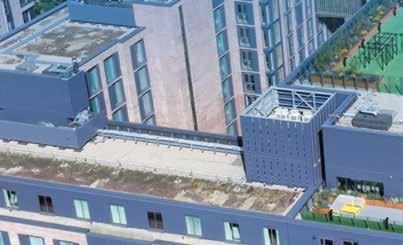










PUBLISHER
Foundation Media Ltd
1 Northumberland Place, Dún Laoghaire, Co Dublin.
Tel: +353 (0)1 677 3157
EDITOR
Robbie Cousins robbie@foundationmedia.ie
DESIGN
Joanne Birmingham
CONTRIBUTORS
John Geraghty, Conor O’Connell, Caroline Gumble
PRINTER
WG Baird Ltd
ADVERTISING SALES
Joe Connolly
joe@foundationmedai.ie
Tel: +353 (0)86 396 6158
ADVERTISING AND PROMOTIONAL OPPORTUNITIES
To advertise in Irish Construction News or on www.constructionnews.ie, or to request a ratecard or details of promotional opportunities, contact Joe Connolly at joe@foundationmedia.ie
CONNECT WITH US ON SOCIAL MEDIA Twitter: @constructionnews.ie
Linkedin: Constructionnews.ie Facebook: Constructionnews.ie
SIGN UP FOR OUR E-NEWSLETTER
To get the latest news, articles and offers related to the Irish construction industry to your inbox sign up to our free e-newsletter at www.constructionnews.ie
ISSN 3088-6562 Vol 05 No 02
© All contents copyright Foundation Media Ltd
While every effort has been made to ensure that the information contained in this publication is correct, the publisher cannot not accept responsibility for any errors, omissions or discrepancies. Views expressed in this publication are not necessarily those of the publisher.

As the government refines various initiatives to increase new housing delivery, the construction industry is setting out what it sees as the most critical issues the government should consider. Significant anxiety has existed within the sector, which is justifiably worried about the rapidly deteriorating housing situation. Recent data reveals a stark decline in new housing starts and only a marginal increase in completions, suggesting another year of disappointing output.
For instance, the Department of Housing’s new ‘Social Construction Status Report’ reveals that the state fell short of its social home delivery target by nearly 20% last year. The report for the final quarter of 2024 indicates that 10,596 social homes were completed, a deficit of 2,334 against the goal of 12,930.
While financial and planning hurdles exist, the government’s inconsistent communication and unpredictable policy decisions are key factors paralysing the overall market. Contradictory signals and the lack of a clear, consistent plan are creating uncertainty, which investors strongly dislike and which is causing builders to delay projects. Examples include statements regarding rent pressure zones, potential tax breaks, and stamp duty changes. To address the housing crisis effectively and attract necessary investment, Ireland needs to establish a stable framework for planning, taxation, and rental regulations, ending the current climate of speculation and indecision.
The alarming drop in construction activity indicates that the lack of consistent policies deters development, not a lack of desire to build. Ultimately, creating a predictable environment is crucial for delivering the
affordable and reliable housing that Ireland urgently needs.
In this issue of Irish Construction News, Michael Hynes and Isabelle Gallagher of Evara discuss the urgent need for more streamlined planning and a less bureaucratic approach to delivering the finance required to build social housing.
Conor O’Connell, CIF Director of Housing & Planning, sets out what he sees as the key issues that need to be addressed to get housing delivery back on track.
Kai Liebetanz, a sustainability expert in nature and resilience, explains why construction industry stakeholders should consider embodied ecological impact when evaluating sustainability.
Caroline Gumble, CEO, CIOB, writes about her recent visit to Ireland, when she received a tour of the National Children’s Hospital and Ireland’s first fully modular school.
Elsewhere in this issue of Irish Construction News, we bring you all the latest news on what’s happening across the industry.
Please take a moment to scan the QR code below and sign up for our free e-newsletter. And, if there are any issues or stories you would like to see featured in Irish Construction News, email me at robbie@foundationmedia.ie
Regards
Robbie Cousins
Scan to subscribe to free e-newsletter




The Land Development Agency (LDA) has announced the acquisition of a new site in Baldoyle in north Dublin, with existing planning permission for 1,931 homes. This site has been earmarked for housing since 2016.
The land is next to the LDA’s Clongriffin land, which means the agency now has the potential to deliver over 4,000 new affordable homes in the area surrounding Clongriffin Station.
The 18-hectare Baldoyle development, formerly part of “The Coast” housing project, has planning permission for enhanced community amenities. These include permanent train station access, a creche, commercial units, new parks, and improved transport infrastructure. Situated east of Clongriffin station, near Stapolin and Baldoyle residential areas, the site is bordered by the Dublin-Belfast railway (west), Fingal County Council (FCC) parklands (north), and the planned Racecourse Park (northeast).
The neighbouring Clongriffin land has the potential to deliver over 2,000 homes. Work has already commenced on a first phase involving 408 homes, which will be delivered in two apartment blocks.
The acquisition of both sites means the LDA is well-positioned to oversee the delivery of over 4,000 new homes in the area and services, amenities and new infrastructure. The LDA is working closely with Dublin City Council (DCC), FCC and other local stakeholders and community representatives to coordinate an integrated approach for the area, which includes land owned by both local authorities.
John Coleman, CEO, LDA, commented: “The purchase of this land is a major strategic accomplishment for the LDA. We now own two neighbouring sites in the area surrounding Clongriffin railway station, and we are positioned to deliver over 4,000 affordable homes in addition to new facilities, services, amenities and commercial outlets. We intend to work closely with the existing communities in this area and with stakeholders to ensure that in addition to delivering housing, we also build on the existing plans for Clongriffin and Baldoyle to create vibrant and sustainable new neighbourhoods.
“The sites we have purchased have been earmarked for development for some time, but projects either stalled or did not get underway. The LDA is well-funded and able to maximise the potential of these sites and, crucially, deliver affordable housing. The LDA is already delivering homes on state-owned land and through


homebuilder partnerships. To speed up housing delivery and to strengthen our development pipeline, we announced our intention also to purchase privately owned sites with planning permission in 2023.
“We have now purchased three major sites, and we expect to announce more acquisitions soon, provided we can complete them at the right price. We are focussing on sites with the potential for a significant number of homes and the opportunity to develop new and vibrant communities.”
In developing the LDA-owned land in Clongfriffin and Baldoyle, the agency will examine and work to support existing plans for the area and ensure they are incorporated into its designs. This includes the Dart+ scheme and FCC’s plans for Racecourse Park.




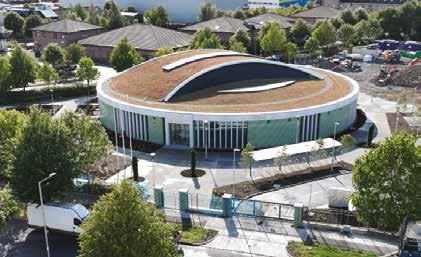

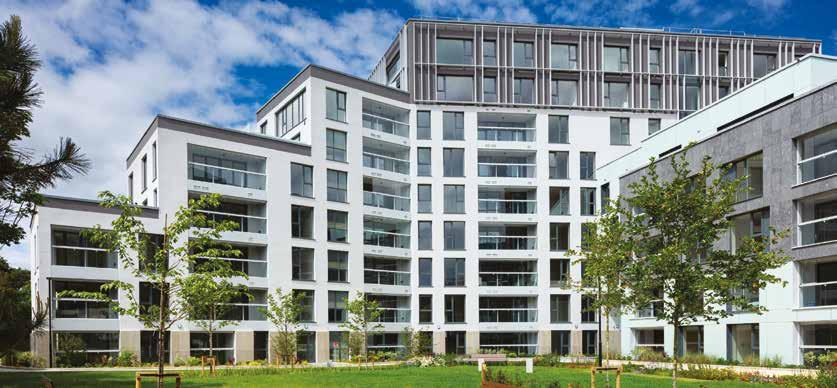




Midland Steel has officially opened its fully automated SMART steel fabrication facility in Portlaoise, with Minister for Enterprise, Tourism and Employment Peter Burke TD on hand to perform the official opening duties.
Anew €16m state-of-the-art Midland Steel facility will create 62 jobs over the next three years, including top-quality engineering positions, robotic technicians, estimators, BIM modellers, mechanical and electrical technicians, and steel fixers, all functioning in a fully automated environment.
The Midland Steel manufacturing facility is the first of its kind in Ireland. The SMART facility represents a major investment in full automation of the rebar cutting and bending process, providing off-site manufacturing of a finished product ready for concrete placement.
The €16m investment highlights Midland Steel’s commitment to modern methods of construction (MMC), showcasing its innovative modular rebar technology solution, FasterFix, which is transforming the construction industry, not only in Ireland but also internationally.
Unique in its approach, Midland Steel’s FasterFix technology offers an MMC solution for housing foundations and concrete substructure and superstructure units. This cutting-edge solution enables developers to achieve a remarkable 75% reduction in total build time, requiring 80% less on-site labour and providing a 30% reduction in preliminary costs for clients to set new standards for efficiency and productivity in the industry.
The new facility also represents a significant milestone for Midland Steel, reinforcing its position as a pioneer in construction innovation. Traditional manual steel fixing operations, involving loose bar cutting and bending to steel fixing on-site, have now been replaced with pre-assembled FasterFix modules designed and detailed by Midland Steel. This approach brings to industry the leanest, greenest, and most sustainable solutions from this facility, with substantial improvements in health and safety.
With the Irish government’s commitment to building 300,000 homes by 2030 as outlined in the Programme for Government document, Midland Steel’s innovative MMC solutions, including FasterFix and Ready Mesh technology, are ideally positioned to support these targets. By enabling faster, more efficient building processes, Midland Steel’s solutions will help meet these ambitious goals without requiring an

of Ireland.
Speaking at the opening, Minister Burke said, “I am delighted to officially open the Midland Steel state-of-the-art fully automated steel fabrication facility. Midland Steel’s innovative FasterFix technology is already transforming efficiency in the construction industry at home and abroad, and it is fantastic to see an Irish company making such impressive inroads across Europe and beyond. The significant investment by Midland Steel in Laois not only reinforces Ireland’s leadership in Modern Methods of Construction but also creates highly skilled jobs in engineering, robotics, and BIM modelling —securing the future of our construction industry. I congratulate Tony Woods and his team on this milestone and look forward to seeing Midland Steel continue to push the boundaries of innovation in construction.”
The SMART facility enables seamless integration from 3D digital modelling to a finished product without manual intervention, improving manufacturing capacity by 60% and making Midland Steel more competitive. The facility achieves 0% waste and has reduced emissions, positioning Midland Steel as Europe’s most sustainable off-site rebar provider.
Leading building contractor John Paul Construction experienced a 75% reduction in its steel fixing programme on its new landmark development, Harcourt Plaza in Dublin 2, resulting in a significant capital cost saving thanks to off-site manufacturing
of modular rebar with Midland Steel’s FasterFix solution, underscoring the transformative potential of this technology.
Tony Woods, Founder of Midland Steel, said: “The official opening of our Portlaoise SMART facility marks a pivotal and proud moment for our family-owned business. The FasterFix modular rebar technology, which we have developed, offers significant benefits for construction projects by reducing installation times and lowering capital costs. FasterFix represents our commitment to pushing the boundaries of innovation in the construction sector. This state-of-the-art advanced fabrication facility in Portlaoise enables us to offer exceptional service, increased capacity and even greater speed and savings to our clients worldwide. I am particularly proud that our HQ remains in Mountmellick, where our business was founded in 1990, and our Portlaoise facility marks a significant step forward in the company’s expansion. We are delighted to make this investment in the midlands region.”
The new Midland Steel facility is part of an ambitious growth strategy, with plans to expand both its operational capacity and its global footprint. The company projects strong revenue growth over the next three years, with an expected €35m increase driven by innovation and expansion. Midland Steel is poised for further overseas expansion with established plants in the UK and Norway, delivering cutting-edge solutions to new international markets.

Grafton Group plc, the international building materials distributor and DIY retailer, has announced that it has agreed to acquire the entire issued share capital of HSS Hire Ireland Limited from HSS Hire Group plc for a total consideration of €31.6m on a cash and debt free basis. The acquisition is subject to approval from the Competition and Consumer Protection Commission (CCPC) in Ireland.
HSS Hire Ireland is a tool and equipment hire specialist operating from four branches and four customer distribution centres in the Republic of Ireland, offering an extensive range of conventional hire products and specialist equipment with a particular focus on powered access.
Following completion, Grafton plans to operate the HSS Hire Ireland business as part of Chadwicks, its market-leading distribution business in the Republic of Ireland.
Chadwicks also operates the successful and highly complementary Sam Hire brand, which focuses on smaller plant and tool hire from 23 locations across the Chadwicks branch network.
The acquisition presents a unique opportunity for Chadwicks to offer its customers a comprehensive national hire service, from small DIY jobs to large civil works.
For the financial year ended 28 December 2024, HSS Hire Ireland generated adjusted unaudited revenue of €31.9m and adjusted unaudited EBITA of €3.9m on a post-IFRS 16 (leases) basis.
Commenting on the acquisition, Eric Born, CEO, Grafton Group plc, said: “We are pleased to have agreed to acquire HSS Hire Ireland, a well-respected tool and equipment hire business

and brand with a strong and experienced management team. This transaction is in line with Grafton’s strategy to strengthen our market positions in existing and adjacent markets. It will broaden the offering of our Chadwicks business in the Republic of Ireland, where we continue to see compelling opportunities for further growth.”
Kingspan Group has been granted the first building permit to begin work on its state-of-the-art building technology manufacturing campus near the city of Lviv in Ukraine.
In 2022, Kingspan announced it was investing in building a new facility in Ukraine, marking the first major investment by a western business since the full-scale Russian invasion began.
The new campus is expected to create over 700 jobs and will manufacture advanced insulation, energy-efficient building material products and district heating solutions, which will be used as part of Ukraine’s reconstruction effort.
Work has now begun on preparing the site for the first phase of construction. A significant portion of the campus is expected to be built within five years.
Low-carbon solutions, including renewable energy, will power the new campus. The building technology deployed and the materials produced at the campus will play an important role in Ukraine’s reconstruction effort and help meet the rapidly growing demand for energy-efficient buildings and facilities in central and eastern

Europe. These technologies are central to the urgent effort to decarbonise the global built environment, responsible for 39% of all energy-related carbon emissions.
Kingspan’s Ukraine Project Director, Mike Stenson, said, “We’re thrilled to get the green light to begin work on the site, which marks a hugely important milestone for us. We were among the first western businesses to announce plans to invest in Ukraine since the full-scale invasion, and we have been fully committed ever since. Working closely with officials local to the site and Ukraine’s
Ministry of Economy and Ukraine Invest we’re very excited for our vision at this stage to become a reality.”
Kingspan acquired the site from Sparrow Capital, supported by CBRE, and has been working closely with project partners, including international architecture, engineering, and consulting firms such as Delta Group, Gleeds, AVR development and law firm Baker McKenzie, as well as local authorities at the site location and Ukraine’s Ministry of Economy together with Ukraine Invest.

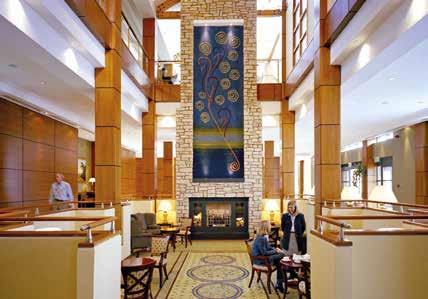


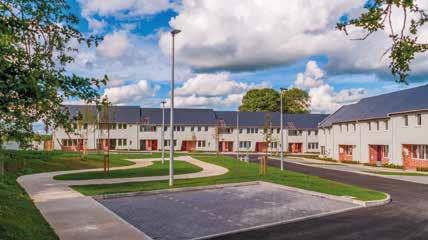
Designer Group has secured the contract to collaborate with Siemens Energy to develop the €1.5bn Celtic Interconnector project.
This is a joint initiative between EirGrid and its French counterpart, Réseau de Transport d’Électricité (RTE) and will establish the inaugural direct electricity link between Ireland and France, facilitating the exchange of 700 megawatts (MW) of electricity across a 575km span.
Paul Nicholls, Group Managing Director, Designer Group, hailed the interconnector as “a hugely significant project for Ireland and Europe,” expressing the firm’s delight in winning the contract, which he believes “reinforces Designer Group’s reputation as an Irish company that can execute and manage large scale energy projects.”
The M&E firm employs 1,250 people across nine countries and will support Siemens Energy in the design of converter stations in both Ireland and France as part of this undertaking. These stations are needed to enable efficient power transmission at 400 kilovolts (kV). Conceptualised in 2016, the subsea Celtic Interconnector cable is projected to cost over €1.5bn, with funding provided by EirGrid and RTE, alongside a contribution exceeding €530m from the EU Commission’s Connecting Europe Facility.
Construction on the project commenced in 2023 and is anticipated to continue into 2026, with grid integration expected by 2027. EirGrid estimates that once fully operational, the link will possess sufficient capacity to power 450,000 homes.

Jones Engineering has announced a new partnership with the Trinity Centre for People with Intellectual Disabilities (TCPID) at Trinity College Dublin alongside its continued support for education through the Jones Engineering Awards at TU Dublin.
As part of its commitment to social responsibility and education, Jones Engineering has joined forces with TCPID to support students with intellectual disabilities in accessing higher education and career opportunities.
Carmel Walsh, Chief People Officer, Jones Engineering, said: “I am delighted to announce our partnership with the TCPID. To offer meaningful employment to people with intellectual disabilities is essential for building a more inclusive, diverse and equitable workplace and society. This collaboration underscores Jones Engineering’s commitment to fostering inclusivity while supporting educational initiatives for individuals with different backgrounds and intellectual disabilities.”
Jones Engineering also congratulated the seven winners of The Jones Engineering Awards at TU Dublin. Each winner receives a financial bursary to support their engineering and performing arts academic journey.

The scholarships, awarded to four students from the Faculty of Engineering and Built Environment and three from the TU Dublin Conservatoire of Music and Drama, highlight the company’s dedication to fostering talent across diverse disciplines. The initiative underscores the synergy between technical expertise and creative innovation - vital in tackling challenges within the architecture, engineering, and construction (AEC) sector.
“Our collaboration with TU Dublin is integral to our mission,” said Stephen McCabe, CEO, Jones Engineering. “We want to incentivise students to strive for academic success and provide tangible support to assist them. Increasing access to STEM education is a key priority, and we are proud to contribute to developing future industry leaders.”
Despite growth in new apartments in Q1, house completions disappointed compared to expectations of an increase, and stockbroker Davy’s forecast of 42,000 units this year looks unlikely to be met. Reforms remain necessary for housing delivery to ramp up, which is even more important as uncertainty due to tariffs slows Irish economic growth this year.
Against a weak annual comparison, the Q1 2025 result of 5,900 new dwelling completions marks another disappointing result. While completed apartments grew 13%, the 2.2% decline in new houses breaks with a pattern seen in 2024 when multi-unit development houses increased by 4.5%. The bigger picture is that current output levels remain far short of a level consistent with the government’s target of 50,000 units per annum. Furthermore, Davy noted in its February Insights report that a higher level again (above 90,000 a year) would needed to address pent-up and new demand by 2031.
Davy’s latest forecast for apartments output in Q1 (1,860) was relatively close to the actual result (1,780). However, there was a notable divergence between the four-quarter lagged level of housing commencements (7.400) and both its forecast (5,800) and the actual result (4,200). Much of its 42,000 forecast for new dwelling completions in 2025 depends on more houses, and the Q1 report’s weak result suggests that this is now unlikely to be achieved. Nonetheless, an increase on 2024’s 30,200 completions should be achievable given the favourable pipeline of commencements.
Davy maintains that a weak level of housing output seems likely until major reforms are fully implemented with respect to rent controls, construction costs and the planning process. The stalled level of housing output, far below what is needed, should provide ample motivation for the government to expedite these reforms. Assuming these reforms take place and priority is placed on addressing wider infrastructure challenges (especially with respect to water and electricity/grid constraints), a pathway to far higher housing delivery continues to be available.
Davy noted in a recent note regarding US tariffs that there is now a greater imperative on efforts to expand Ireland’s domestic supply capacity given the likelihood that

“Our view remains that a weak level of housing output remains likely until major reforms are fully implemented with respect to rent controls, construction costs and the planning process”
– Kevin Timoney, Chief Economist, Davy.
trade and geopolitical tensions will cause a slowdown in foreign direct investment as the main driver of Ireland’s economic growth. Ireland also has many favourable structural advantages as it faces into the latest external shock. These include:
A very strong national financial balance sheet;
A well-educated and growing population; Lower wage costs for high-skill activities compared to the US; Access to the EU single market; and, A strong ranking internationally with respect to institutional governance.
Kevin Timoney, Chief Economist, Davy, commented: “Despite growth in new apartments in Q1, house completions disappointed compared to our expectation of an increase, and our forecast of 42,000
units this year already looks unlikely to be met. Reforms remain necessary for housing delivery to ramp up, which is even more important as uncertainty due to tariffs slows Irish economic growth this year.
“Our view remains that a weak level of housing output remains likely until major reforms are fully implemented with respect to rent controls, construction costs and the planning process. The stalled level of housing output far below what is needed should provide ample motivation for the government to expedite these reforms. Assuming these reforms take place, and priority is placed on addressing wider infrastructure challenges (especially with respect to water and electricity/grid constraints), a pathway to far higher housing delivery continues to be available.”
Co-operative Housing Ireland (CHI) has launched 40 new homes at Forthview, Wexford and emphasised to visiting Minister for Housing James Browne the key role of approved housing bodies (AHBs) in meeting social housing needs.
The homes were delivered in partnership with Wexford County Council and the Department of Housing, Housing Finance Agency and developer Darragh Ryan.
Speaking at the launch, Gerry McDonogh, Chairperson, CHI, thanked Minister Browne, emphasising the strong partnership CHI has with his department and the need for funding to increase to keep pace and to deliver more social housing, “To enable CHI and AHBs to keep pace with current delivery targets - even before any revisionincreased funding, a proportion in the form of grants, is required. As it stands, 10,000 new social homes are to be provided in 2025, half of which will be by AHBs. The Programme for Government and future targets should see this increase to an average of 12,000-20,000 yearon-year to 2030.”
Minister Browne said: “I am pleased to see these much-needed homes here in Forthview, Wexford today. This project has been enabled by funding from my department’s Capital Advance Leasing facility and reflects the strong state and voluntary sector collaboration needed to make these projects happen. I would like to commend CHI, Wexford County Council, the Housing Finance Agency and the Housing Agency for working together to deliver these homes.
“I want to see many more projects like this. The government,

(L to r): Eimear Lynch, Neighbourhood Delivery Manager, Co-Operative Housing Ireland; Minister for Housing, James Browne TD; and Gerry McDonogh, Chairperson, Co-Operative Housing Ireland.
through an unprecedented level of state investment, is now scaling up and delivering more social and affordable homes than we have in a generation and aims to provide even more. You can see the difference these projects make here today. Well-located, high-quality homes such as Forthview make a real difference in the lives of families, individuals and communities - it is for this reason we are committed to working in partnership to build on the momentum of Housing For All.”
PJ Hegarty has been accredited with the Investors in Diversity Gold award by the Irish Centre for Diversity (ICD), a charity and leading provider of D&I training in Ireland. The accreditation recognises PJ Hegarty’s commitment to embedding the principles of fairness, respect, equality, diversity, inclusion and engagement (FREDIE) within its culture and processes.
In 2020, the company decided to explore ways to create a diverse and inclusive business in a formal manner after recognising that across the Irish construction industry and the key professions from which PJ Hegarty hires, widespread diversity was not the norm, and a gender gap persisted.
The ICD assessment team has recognised PJ Hegarty for implementing several progressive, strategic policies that have seen it earn an official inclusion score of 88% - some 10% above the national average. The ICD said PJ Hegarty had provided the appropriate resources and led by example. The work also showed that team members feel they are treated fairly with respect and are valued for their differences.
Along with progress in Gender Pay Gap reporting, the ICD assessment team noted the company’s development of a new threeyear strategy, which takes account of both moral and business obligations; the introduction of updated maternity, mental health and wellbeing policies; the alignment of FREDIE principles to staff development, staff appraisals, and recruitment processes and the offer of D&I training sessions to subcontractors and partners.
Overall, the firm received an inclusion score of 88.8% from the ICD, an increase of almost 5% compared to 2022.
Commenting on the award, PJ Hegarty Operations Director and Chair of the company’s DEI Steering Committee, Maurice Killeen, paid tribute to the team’s commitment to D&I principles and willingness to make them central to the business’s long-term strategy.
He said, “Our people have always been the focal point and strength of our company, and the evolution of our business by fostering a diverse, inclusive, and supportive environment to reflect their needs and societal change more broadly has been central to our culture and long-term business strategy. We are delighted to have been awarded the Gold accreditation from the Irish Centre for Diversity (ICD), joining only 27 other businesses in Ireland who have achieved this distinction.”
Caroline Cummins, Managing Director, ICD, commented: “PJ Hegarty’s progress to Investors in Diversity Gold has been impressive. It has laid firm foundations and listened to all colleagues’ voices to ensure a shared sense of belonging, and now they are proud holders of Investors in Diversity Gold. We look forward to sharing more about the company’s continuous journey of progress.”

Ronan Group Real Estate (RGRE) has held a ‘topping out’ ceremony at the new European headquarters building for Citi at Waterfront South Central, Dublin. The event was attended by Nacho Gutiérrez-Orrantia, CEO, Citibank Europe Plc, Davinia Conlan, Country Head, Citi Ireland; Rory Williams, CEO, RGRE; Johnny Ronan, Chairman, RGRE; Aidan Gavin, CIO RGRE; and Quinton Allen, Regional Construction Director, PJ Hegarty & Sons.
The building comprises 12 storeys, including a triple basement, and will provide 459,000 sq ft of state-of-the-art commercial space with the highest standards of design and technology.
When the building is completed in 2026, Citi will take ownership of one of the most sustainable sites in its global real estate portfolio.
Nacho Gutiérrez-Orrantia said: “Today marks a significant milestone in the development of Citi’s new European headquarters in Dublin. This state-of-the-art new building at Waterfront South Central will serve as a dynamic space that fosters innovation, collaboration and growth for years to come and underlines the depth of our commitment to Ireland, to Europe and to our people and clients.”
Rory Williams, Ronan Group CEO, said: “We are delighted to welcome Citi to the topping out ceremony for their new corporate offices in Dublin today. This development exemplifies Ronan Group’s expertise in delivering world-class buildings and we are proud that this will become one of the most sustainable offices in Citi’s global real estate portfolio.
“Waterfront South Central (WSC) will be a jewel of the Docklands with Citi’s striking design at one end and a 25-storey residential tower at the other overlooking the Liffey as it flows into Dublin Bay.”

Ronan Group has deployed the latest technologies to ensure the highest energy, digital and healthy building scores possible targeting a LEED v4 Platinum green building rating, a WiredScore platinum rating for the building’s digital capabilities and WELL Platinum for its interiors & base building, certifying a healthy and productive workplace. It is also aiming for the Zero Carbon certification and a Building Energy Rating of A3.
Alandmark building in Ballinasloe will be transformed to include a new community facility as part of a 16-unit residential housing development in the centre of the east Galway town.
Galway County Council has signed contracts with Custy Construction Ltd and OBFA Architects to deliver the scheme, which is being financed under Housing For All and directly by the local authority.
Work on the Dunlo Hill development includes the renovation and extension of the existing terraced buildings and the conversion of the currently derelict Dooley’s Pub from a public house to include a community facility.
The residential housing development comprises 10 two-storey one-bed dwellings; two two-storey two-bed dwellings; one single-storey, onebed apartment; one duplex one-bed apartment, and two duplex two-bed apartments, 16 units in total.
The project is scheduled for completion by July 2026.
Councillor Martina Kinane,
Cathaoirleach of the County of Galway, said, “This is a milestone scheme for Galway County Council and the town of Ballinasloe that will bring about the transformation of a derelict site into a vibrant new community space and residential development. With 16 modern residential units and a restored community facility, this initiative marks a significant step forward in revitalising the town centre while meeting the housing needs of our community.”
Councillor Michael Connolly, Cathaoirleach of the Ballinasloe Municipal District, commented, “The elected members are fully supportive of this development as it will inject new life into the Dunlo Hill area of the town by bringing back into use the terraced homes and public house that have been lying vacant for several years. I want to commend the staff of the Galway County Council’s Housing Department for their vision in delivering this badly needed scheme, which will deliver modern housing and revitalise the heart of the town for generations to come.”

Pictured outside Dooley’s Pub in Ballinasloe, (l to r): Ciaran O’Brien (OBFA Architects); Dermot Custy (Custy Construction); Ballinasloe MD Cathaoirleach Cllr Michael Connolly, Cathaoirleach Martina Kinane; Alan Brogan (Galway County Council); and Michael Owens (Director of Services for Housing, Galway County Council).


David Flynn Limited (DFL) has appointed three new members to its board of directors as the company celebrates 40 years in business and forecasts significant growth in the coming years.
Senior DFL employees John Ryan, Joe Dempsey and Ray O’Brien will join existing board members as the company faces a busy time ahead.
With offices in Waterford, Dublin and London, DFL is one of
the largest building contractors in the south east. It is a major employer in the region, with a combined staff of over 100 across the construction company and its fit-out division, DFL Fit Outs and Joinery Limited. Several hundred more are employed as subcontractors.
Amongst the company’s major projects due to begin this year is a large-scale cancer treatment centre in Limerick in a multi-million euro contract, while it is expected to complete almost 200 houses across various sites in the south east by the end of 2025.
DFL’s turnover last year was €60m, with an ambitious plan to grow this over the next three to five years.
John Ryan joins the board of DFL after more than three decades with the company. He has overseen hundreds of projects, from residential and high-rise apartments to commercial, industrial, pharma, fit-out, healthcare, education, and civil engineering projects.
Ray O’Brien has been with DFL since 2015 and has worked in the construction industry for 20 years.
Joe Dempsey brings an extensive 26 years of experience in construction to the board, having worked in both the Irish and UK construction industries as a quantity surveyor since 1999.
Martin Markey, Chief Executive, Hardware Association Ireland.
Commenting on the appointments, DFL Managing Director David Flynn said: “The three new board members bring with them exceptional experience across a broad range of sectors and will complement our existing board. I have no doubt the full board will collaborate very effectively together as we face into one of our busiest years to date and reflect on 40 years of success across Ireland, the UK and Europe.”
Approved housing body (AHB) Respond has appointed Aoife Watters as its new chief executive officer (CEO). She becomes the organisation’s third CEO and the first female CEO in its 40-plus-year history. The board has taken care to ensure a smooth and orderly transition working with the current CEO and its executive management team.
Previously having served as CEO of Dublin Cemeteries Trust, Watters brings a wealth of experience from both the commercial and charity sectors. She has served as a board director and chair with another AHB, also chairing its Finance and Audit Board Subcommittee. She was finance and corporate services director for a large crossborder housing and homelessness charity.
Respond is Ireland’s largest construction-led AHB and services provider. With over 18,000 social and cost rental tenants nationwide, Respond has a tenant satisfaction rate of 89%. Speaking about her appointment, Aoife Watters said: “I am honoured to join Respond and to have the opportunity to lead this exceptional organisation. Respond’s values and guiding principles are very much aligned with my own. I have long admired Respond’s reputation for delivering high-quality homes and embedding them in communities where people can build their lives.”

The board of Walls Construction Holdings Limited has announced the appointment of Adrian Corcoran as Managing Director and Frank Kelly as Executive Chairman of Walls Construction Limited. These internal appointments are part of a strategic consolidation of the senior leadership team, which will see Eugene O’Shea and Willie White remain on the board of the group holding company.
Adrian Corcoran, who joined Walls in 2000, and Frank Kelly, who joined in 1992, were both promoted to the board in 2007 and have played a pivotal role in driving the company’s success. They have a track record of delivering results across all its business sectors together with proven talent for client engagement and customer care, commercial management, project control and delivery, while contributing to the ongoing development of the company’s business systems.
Commenting on the appointments, outgoing Walls Construction CEO Eugene O’Shea, said:
“In their current roles as chief operating officers, Adrian and Frank have
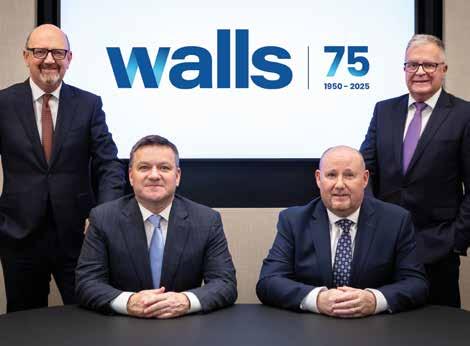
management styles, skills and abilities that are complementary, and, working collaboratively, they will provide inspiring leadership to day-to-day decision-making
and long-term strategy, to position the business for continued growth and success into the future.”
Cairn has announced two new internal promotions to its senior leadership team, with Gavin Whelan appointed chief operating officer (COO) and Gerald (Ger) Hoare as chief investment officer (CIO).
Commenting on the appointments, Michael Stanley, Chief Executive Officer, Cairn, said: “I am delighted to announce the appointments of Gavin and Ger to these key
strategic positions within our business. We have an exceptionally strong team in Cairn, and these key leadership appointments will help support the business as we continue to scale and drive further significant growth in housing output in 2025 and beyond. In their new roles, Gavin and Ger will play a crucial part in supporting the continued success of the business.”
Gavin Whelan joined Cairn in January

2021 as director of construction & operations. Since then, he has been responsible for overseeing the design, delivery, and operational support of the Cairn delivery platform, with a focus on scaling the business, refining Cairn’s product, and driving innovation and productivity. In his new role as COO, he will be responsible for leveraging all aspects of Cairn’s operating model, aligned with its next stage of growth.
Gavin Whelan commented: “I am excited to step into the role of COO. My focus will be to build on Cairn’s strong foundation of delivering high-quality homes in the Irish market at scale and pace.”
Ger Hoare joined Cairn in June 2017. His most recent role was director of business development. He will now be responsible for driving sustainable growth for the business with a key focus on meeting the demands of our customers and markets while expanding our product offering.
Ger Hoare commented: “I am delighted to be stepping into the role of CIO at Cairn. I am excited about the opportunities ahead. In this role, I will focus on driving the evolution of our product offering, always keeping the customer at the heart of everything we do.”


CPAS is a construction industry specific pension provider. Whether you are an employer seeking to provide benefits for your employees or planning your own retirement, CPAS has the right solution for you.








Our dedicated team are here to support you, whether you are starting your business, growing your business, or planning for your future.
For more information, please get in touch today.






JOHN GERAGHTY, Business Development Consultant, CPAS, writes
that with Auto-Enrolment coming, employers face critical choices on integrating existing pension schemes or adopting the new system, requiring swift planning and communication.
Automatic-Enrolment introduces mandatory retirement savings requirements into Irish law for the first time. These requirements are due to start on 30 September 2025. The Department of Social Protection has recently commenced communications with employers in this regard. With this in mind, it is now imperative that employers understand their obligations and ensure they have a plan in place that suits their business and their approach to employee benefits.
Employers should decide whether they wish to use their existing pension arrangement to meet the requirements of AE or whether they will operate a dual system, ie, continue the existing arrangement alongside the AE system. At present, membership of a pension scheme or Personal Retirement Savings Account (“PRSA”) with any level of employer/employee contribution means employees will not be automatically enrolled into the AE system. If existing arrangements are to be used alone, there are a number of key steps to take:
• Ensure all employees not currently members of the scheme join the scheme.
• An employee communication exercise will be required to inform employees of the changes.
• Amendments will be required to scheme documentation regarding membership provisions.
• Employers should consider whether there are cohorts of excluded employees and whether (and how many) employees have opted out of the scheme, and why.

For employers who do not currently operate pension arrangements, now is the time to consider the best option for their employees and their business.
• Is it preferable to allow employees to be automatically enrolled into the AE system, or
• Would membership of a Master Trust, Multi-Employer scheme, occupational pension scheme, or PRSA be a better choice into the future?
We encourage employers to complete their considerations and implement any required actions by the beginning of July of this year. A July implementation date will hopefully avoid any administrative difficulties that might arise as the new authority implementing the AE system can apply a “look back” period of up to 13 weeks to determine the correct pay reference period for an employee to assess whether they are in scope for AE.
Eligibility for the scheme encompasses employees aged between 23 and 60 years of age who earn over €20,000 per year

unless they already participate in another pension arrangement. Both employers and employees are expected to contribute to the scheme, beginning at a rate of 1.5% each, gradually increasing to 6% over a 10-year period.
There are noteworthy distinctions between auto-enrolment and existing occupational pension schemes that employers should be aware of. For instance, auto-enrolment does not provide tax relief like traditional pension arrangements. Instead, a state top-up comparable to 25% tax relief is offered. Employers running an auto-enrolment scheme alongside another occupational pension arrangement should familiarise themselves with the two different taxation systems that will be applicable to payroll. Occupational pension schemes are more advantageous for pension scheme members paying 40% tax, while the auto-enrolment scheme may have a greater impact on the take-home pay of taxpayers on the 20% rate.
Additional Voluntary Contributions (AVCs), which allow members to enhance their retirement outcomes by contributing more to their pensions, are not currently possible under auto-enrolment. Moreover, auto-enrolment does not offer additional benefits such as life cover, sick pay, and income protection, which are valuable incentives for employers seeking to attract and retain key personnel.
Employers should seize this opportunity to assess their needs and implement a solution that suits them best.
For further assistance with preparing for auto-enrolment, you can reach out to John Geraghty, Business Development Consultant, CPAS, via email at j.geraghty@ cpas.ie
CPAS manages the Construction Workers Pension Scheme (CWPS) and the Construction Executive Retirement Savings (CERS), and it provides additional financial support services through Milestone Advisory DAC.

Following a major investment from TPG Real Estate and a rebrand, Evara (formerly Quintain Ireland) aims to ramp up housing delivery to 1,500 homes annually by 2027. CEO Michael Hynes and Isabelle Gallagher, Head of Development, speak with ROBBIE COUSINS about the company’s growth strategy and solutions to Ireland’s housing crisis.
In February of this year, Quintain Ireland, the country’s largest privately owned residential developer, announced that it was rebranding to Evara. The rebrand followed TPG Real Estate’s strategic partnership with Quintain Ireland’s management to acquire the homebuilder from its original shareholder, Lone Star, in August 2024.
The investment will support the next stage of the homebuilder’s growth and evolution as it seeks to accelerate its housing delivery to reach an output target of 1,500 homes a year.
Although only founded five years ago, Evara has been delivering an average of 650 new homes a year since 2023, has a landbank with the potential for a further 7,700 homes and is close to employing 120 people, double the number employed 12
months ago.
Evara CEO Michael Hynes and the senior executive team have mapped out a plan that will see the company continue to grow at a similar if not greater rate over the next 18 months with the support of TPG, which he describes as a transformational investor, here for the medium to long term and looking to help address the problems that exist in the Irish housing sector.
Opening our conversation, Michael Hynes reflects on what was a very exciting 2024 for Evara on two fronts.
He comments, “2024 was a really big year for Evara, on two fronts, in particular. One was operations and the scale of what we delivered, and the second was securing a new shareholder.
“On the completions front, we had been building an average of around 650 homes
over the two years prior to 2024. Last year, we had a small reduction in completions to 600 units, with a total gross development value (GDP) of €300m.
“Moving forward in 2025, we’re on target to build close to 1,000 units this year, and our ambition is to achieve 1,500 units per annum. With over 2,000 units currently under construction, we are confident of getting to 1,500 units by 2027.
“Looking back on 2024, achieving 600 housing completions meant we were still the largest private house builder by completions.”
He adds, “One of the biggest issues in the market at the moment is securing capital. The Department of Finance says that approximately €21bn a year is needed to build 50,000 homes. They see only €4bn of this coming from state funds. So,
approximately €17bn has to come from the private market.
“Evara became one of the first housebuilders in the country to change shareholder and secure equity capital at scale for house building with the TPG investment last year. TPG are a transformational investor with the goal of leaving a company in which they invest in a better strategic position. They are a growthorientated investor and are a great company to partner with from a process perspective, which was evident from an early stage of our engagement. They will provide the capital necessary to continue to grow the business. So, securing TPG’s investment could be seen as a bigger achievement for us than our scale of output last year.”
Isabelle Gallagher characterises Evara as a company dedicated to building “integrated communities at scale”. Elaborating on this, she states, “We see Evara as a business that builds communities and towns, as opposed to housing estates. This is an essential part of our identity.”
Isabelle Gallagher emphasises Evara’s comprehensive approach, explaining, “Evara looks at the wider picture because we have significant landbanks in key areas that can accommodate housing at a scale that supports this objective rather than having a collection of scattered individual sites. This allows us the creativity to work out from a master planning perspective, creating sustainable towns of interconnected spaces.”
She further highlights Evara’s longterm perspective: “We plan from a crossgenerational perspective. We consider developments in terms of how they might evolve long after we’ve moved on and the original homeowners and occupants have moved on. We want Evara developments to stand the test of time. We consider green spaces, the overall flow of the development, adjacency to public transport, and how the road network is designed, including room for cycle tracks and off-road paths, as well as all of the amenities that are going to be needed, such as community centres, parks and recreational space, retail, creches, and so on. We determine the right mix of unit types to ensure that people from all generations can live and thrive together.”
Reflecting on Evara’s accomplishments, Gallagher notes, “We’re proud of what our people have achieved up to now across our landbanks in Adamstown, Portmarnock and Cherrywood, and we still have quite a lot to deliver through our placemaking. Much of what we do is predefined as the land in question is in a Strategic Development Zone. But we aim to create safe and accessible communities for all, making us unique as a business that builds
modern, sustainable communities.”
Addressing the external challenges facing Evara, Isabelle Gallagher highlights the significant infrastructure deficits confronting housebuilders in Ireland. She emphatically states, “We see the infrastructure deficit as one of Ireland’s biggest threats to housing. It’s not just about water infrastructure, there are also energy, roads and public transport challenges. What we find surprising is that the issue is not really discussed much outside of the industry. You often hear people talk about planning, and people outside the industry understand there are planning problems. But the real problem is the lack of, and barriers to, new infrastructure. We were happy to see this issue referenced in the Programme for Government, and the government has intentions of setting up a task force to look at how it can be addressed. We would welcome such a body.”
Expanding on the need for proactive infrastructure planning, Michael Hynes adds, “We need to be planning now for the infrastructure needed beyond 2030 and further ahead. The industry doesn’t want to find itself down the road having achieved a delivery rate of 60,000 homes per annum, then one year coming to a sudden drop back to 20,000 or 30,000 homes because the infrastructure needed hasn’t been delivered.”
With TPG now as a shareholder, Michael Hynes outlines Evara’s ambitions for immediate expansion, stating, “At the
moment, our landbank is at around 7,700 unit capacity, over 60% of that is planning permitted, so we have a very clear roadway to commencing on-site and getting to our target number of 1,500 housing completions per annum by 2027. We currently have over 2,000 units under construction.”
Hynes identifies three key areas of focus for the next 18 months. Firstly, regarding the team, he emphasises, “It’s essential as our business is doubling in size that we hire the right people to match the company’s growth ambition. But it’s not just about hiring and making sure your business sizes up. We also have to retain the talent that we have and have developed and identify rising stars in the business so that they stay with us.”
Secondly, Hynes highlights the importance of efficiency: “The second key area is innovation and improving our processes. It’s really important as we move towards delivering 1,500 units a year. Not many companies in Ireland have ever got to that level of scale, never mind trying to do it every year into the long term. Having looked at housebuilders across Europe, the key to success is having good processes in place and innovating them all the time. Standardising our house types further, for example, and making them well space planned in terms of space and of an efficient size is essential. This also applies to apartment designs to make sure that we develop apartments for living, but also ensuring that we’re not wasting space and keeping costs to a minimum. As a business, we are moving towards 120 people who will be on over 10 sites at once. Standardising our internal processes around planning and costs and improving our relationships and





Explore Careers with Elliott Group




frameworks with supply chains is pivotal to our future success. If we can get value for scale, we can deliver more affordable housing to market.”
According to Michael Hynes, the third and most significant element is acquisitions. He explains, “With TPG as a new shareholder, we have spent the past month meeting with the biggest land agents around town, advising them that we will be looking to deliver all of our 7,700 landbank units over the next five years. That means that we’ll be looking to replace our 7,700unit landbank over the next three years to have sufficient land to continue building at scale.

“Land acquisition is the biggest activity happening in the business right now. We’re looking at the greater Dublin area. Our preference is for sites with the potential for 500+ units. We’d love sites of 1000+, but there are not too many of those due to the fractured ownership of land in Ireland. We don’t believe there are too many companies buying land in Ireland at the moment because there simply isn’t a huge amount of capital. If we are successful in acquiring land, it is because we have the capital in place to do it, and we can move quickly.”
He elaborates on Evara’s land acquisition strategy: “Our ideal would be to have 8,000 sites on our books at any one time. Fifty per cent of that should be planning permitted or close to it to provide certainty to our pipeline. We think another 20% should be zoned and capable of achieving planning within three years, the next 20% should be zoned but might have some infrastructure or ownership challenges that could mean it could be four to five years to get planning underlined, and the final 10% of the book can be unzoned. As a developer business, we also have a responsibility to bring
land through to
land to make sure it’s the right land coming through.”
Concluding on this crucial objective, Michael Hynes comments, “Replacing the entire landbank that we have today and getting the new land and infrastructure is the biggest goal we have for the next 18 to 24 months.”
Isabelle Gallagher expresses cautious optimism about government intentions to address obstacles to housing delivery, emphasising the need for clearer communication and inclusive dialogue. She states, “There are a few signals from the government that we like, such as a housing supply task force, which they say will open up infrastructure and might help join the communications gaps between the local authorities, infrastructure providers and housebuilders. We would like to see private sector representation on that task force because I think the difficulties experienced in the private sector are sometimes not translated well into the public sector.”
Gallagher stresses the importance of the government enabling industry capacity and fostering a more attractive environment for investment. She explains, “In terms of unlocking capacity and creating conditions for investment, zoning is a big issue. Everyone may talk about planning, but zoning is the bigger issue coming down the tracks. The government is saying the right things about zoning now that the new National Planning Framework is coming through and the numbers are being updated for housing output. Local authorities are being asked to look at their own jurisdictions and see what should be zoned.
But they need to get over the fear about zoning too much land. When you look at all the other constraints in the system, how could we ever have too much land zoned? It is the first point of a long process.”
Later this year, Evara will complete the single largest scheme the Land Development Agency (LDA) will take to date with The Irons Building (392 apartments) in Adamstown. Evara is also on the Project Tosaigh Two framework. Michael Hynes states, “Our relationship with the LDA, approved housing bodies (AHBs), local authorities, and the state’s other housing agencies is excellent, and we look forward to continuing to work with them.”
Isabelle Gallagher concurs but notes, “Frustration for all stakeholders with the bureaucracy involved with some government schemes.
“Regarding social and affordable housing funding,” she explains, “A certain amount of funding is announced every year in the Budget. But it’s unclear how much of that has been pre-allocated, when it will be allocated, and if it is enough.
“For example, we might agree on a price with an AHB seeking to take a block of apartments. This is lodged for approval with the Department, and we could wait up to six months to find out if approval is granted. If successful, it next goes to the Housing Finance Agency (HFA) for a second round of funding approval. If the project clears these two phases and is approved, there can be a further delay in getting through the HFA legal documentation process. The HFA has just one legal practice to do all the work.”
She adds, “By the end of the process, a year may have passed, with much time and money expended by all stakeholders. We then have a contractor who is expected to hold their tender price for 12 months, which is impossible. Developers are ending up having to start on-site at risk, hoping they get the approval and the funding comes through because their contractor simply won’t be able to hold their price.”
She also adds: “This whole situation could be easily resolved by showing what funding is available at the start and streamlining the process. If funding isn’t available, fine, we can look for an alternative solution with the AHB.”
Working with TPG, Evara has been reviewing its ESG plans and what it can achieve over the next 18 months.
Michael Hynes explains, “We’ve completed a full analysis of our business under three core principles: People, Places and Planet. Under these headings, we’ve identified what we’re doing right from a sustainability perspective. Now, we’re looking to improve on that year by year.”
Providing an example of their environmental plans, Hynes mentions, “The big challenge for all house builders is addressing our carbon footprint. We’re committed to measuring our carbon footprint by the end of 2025. This is a huge task because we have to look at not just our own carbon footprint as a business but the carbon footprint of everything that happens on our sites, from contractor to subcontractor perspective, and all of the materials, logistics, accessibility and diversity of people on our sites.”
Outlining the collaborative approach required, Hynes adds, “To achieve this, we need huge buy-in from our supply chains and design teams. The majority have committed to working with us, and by the end of the year, we will have completed the measurement process. We’ll then put targets in place to reduce our carbon footprint as we go forward.”
Isabelle Gallagher emphasises Evara’s rapid expansion in its initial five years, which was supported by a highly experienced team. She explains the company’s new focus on cultivating the next generation of talent: “Recruiting and retaining the right people is essential to us. Bringing younger people into the businesses is very much part of that, and growing them organically through the business.”
Gallagher elaborates on this strategic shift: “To develop at such a fast pace over our first five years, we needed a senior, experienced team in place. We are now looking to bring in younger professionals. We’re looking for people from different professional backgrounds. We have planners, engineers, and surveyors. We have architects, salespeople, legal people and creative people. We have quite a diverse range of skills across the business. Bringing in younger people will help us grow, and we will nurture the right talent through the Evara journey. It is good to get people when they’re starting out and full of enthusiasm, and we can train them and equip them to develop long-lasting careers with us.”
Gallagher also highlights Evara’s commitment to diversity, noting, “From a diversity perspective, excluding Michael, our CEO, our executive committee is 50/50 men and women, so we are evenly balanced, which is unique in this industry. My team is about 60% women, so we have quite a strong track record in attracting women into the workplace, and we plan to continue that.”
She mentions a new initiative in Evara’s construction division, adding, “More recently, we have been building a selfdelivery construction team. We plan to bring people through from apprenticeship level onwards in this. This is part of our 18-month plan to bring that through.”
Michael Hynes and Isabelle Gallagher state that Ireland’s housing crisis will continue
to escalate if the shortfall in supply is not addressed. They say this can only be addressed by reducing barriers to delivery and making the country more attractive for capital investment.
Michael Hynes comments, “In fairness, the Programme for Government is ambitious. We’re excited that the government is targeting the delivery of 300,000 homes by 2030. They appear to be trying to put as much resources towards it as possible. We met the new housing minister, who appears to understand the issues. Now we’re asking, having listened to stakeholders, public and private, when will they bring in the necessary policies. If they have heard what is being said and act accordingly, there’s a chance of getting those 300,000 units built. But it will be a real challenge.”
Isabelle Gallagher points to the sector’s commitment to the task ahead, adding, “When we met the minister, we pointed out that there is a highly motivated sector here. Most people who work in construction and house building are driven by a passion for what they do. We do it because we love it, and we know what is required to fix the problem. They just need to remove the barriers to delivery.”
Michael Hynes highlights the potential for attracting investment, “Evara managed to secure capital from a highly skilled private equity firm that is here to help solve the problems in the housing sector in the medium to long term. Irish companies can attract good capital to Ireland. Our economy is one of the best performing in Europe, with appealing demographics. There is a housing crisis, but there is also an opportunity and more capital needs to be brought in to solve that crisis.”
Michael Hynes concludes by urging the government to streamline processes, saying, “The government needs to make the process of delivering housing simpler, whether that is fixing the planning process, reviewing the cost of building apartments or tweaking the supply side.”


We take immense pride in our 66-year heritage in Ireland and the signifi cant contribution we’ve made to the country’s built environment. And we are committed to building on this unique legacy for the long term.
From renowned product quality and ease of installation to trusted technical support, there’s a reason professionals reach for Wavin drainage, plumbing and water management solutions.
Now, with plans to create a state-of-the-art distribution hub and training academy, whilst continuing with product innovations and our good works in the community, we’re building even better partnerships and, together, an even better Ireland.
wavin.ie









Pipelife Ireland MD Conor Manning, recently appointed following the retirement of Gerard Healy, talks about his background and plans for the business moving forward...
“I have been with Pipelife for over 20 years, which has allowed me to witness and contribute to the company’s evolution and growth within the industry. My journey began in various operational roles, where I developed a deep understanding of our products, processes and, most importantly, our customers’ needs. For the past 10 years, I have held the position of operations director. In this capacity, I have been an integral part of the senior leadership team, helping to shape the strategic direction of the business. My commitment to fostering a strong customer-focused culture has been paramount; I believe that understanding and anticipating our customers’ needs is essential to our success. This focus ensures that our services and products consistently meet, and often exceed, customer expectations.”
“As I transition into my new role as managing director, I remain dedicated to driving our success further into the future. I am committed to continuing our emphasis on customer focus and operational excellence, while exploring innovative strategies to ensure that Pipelife remains a leader in our field.
“I aim to bring:
• Enhanced efficiency & productivity: Streamlining operations, optimising processes, and ensuring we maintain record-high levels of output, quality and customer satisfaction.
• Business growth & expansion: Identifying new opportunities, strengthening partnerships, and positioning Pipelife for long-term success.
• Sustainability & innovation: Leading initiatives that align with modern energy efficiency and environmental goals, ensuring we stay ahead in renewable heating and piping solutions.
• Strong leadership & people development: Investing in our team, fostering collaboration and ensuring a positive and motivated workplace culture.
• Customer-centric approach: Strengthening relationships with clients and stakeholders to deliver solutions that truly meet their needs.”

“The future for Pipelife Ireland is filled with exciting opportunities, innovation, and sustainable growth. As we build on our 55-year legacy, we are committed to staying ahead in the industry while supporting Irish jobs and delivering market-leading solutions. Our primary goal is to be a provider of industry-leading products and services to the building sector. We recognise that modern systems require fully designed specifications that our customers can have confidence in, and we are investing heavily in in-house design services. Many customers are actively seeking ‘one-stop’ shop suppliers that have the scale, financial strength and credibility to be a long-term supply partner. This is ever more important in the building sector in general where the
end products need to be supported over a life span measured in decades. Developers, builders and homeowners are faced with ever-increasing upfront costs for new builds, with regulatory changes and the move to low-temperature, low-emission heating systems impacting building design and heating systems. Scale brings efficiency, so the greatly enhanced scale of the new Pipelife Ireland will allow us to invest and provide competitively priced, class-leading design services and products.
Pipelife has a very strong commitment to achieving world-class results in its ESG targets. On a group-wide level, Pipelife is leading the way within the industry to improve safety, reduce its carbon footprint, and design its products to maximise their potential in a truly circular economy.”

A ClearyDoyle €3.2m infill development in Old Bawn, Tallaght, has delivered high-quality, energy-efficient homes for older residents, fostering community and accessibility while setting a benchmark for future age-friendly housing projects.
Brady’s Court, Old Bawn, Tallaght, is a prime example of infill development carried out by ClearyDoyle. With a project value of €3.2m, this development integrated new housing into an established suburban community. The project was tailored to meet the needs of older residents, offering an attractive and practical opportunity for those seeking to ‘right-size’ their living arrangements.
Commissioned by South Dublin County Council, the project comprised the construction of 12 A1 BER-certified residential units and a two-room community facility, all arranged in a courtyard form. The development also included associated site works and landscaped green spaces planted with native flowers, shrubs and trees to enhance the visual and ecological appeal. Each of the A1 BER-certified homes complies with NZEB standards, reflecting the project’s emphasis on sustainability and energy efficiency.
The residential units were thoughtfully designed by architect O’BF_A to cater to diverse needs. The scheme comprises eight single-storey, single-bedroom units with living room and kitchen
accommodations. Additionally, there are two, two-storey buildings, each containing two two-bedroom apartments, bringing the total to four such units. This combination ensures that the development offers a variety of housing options suitable for different living arrangements.
The community facility, a key part of the project, completes the courtyard layout. It houses multi-purpose rooms, a kitchen and accessible toilets, offering a valuable communal space for residents. Strategically placed between Brady’s Court and the busy Oldbawn Way Road, it acts as a buffer, enhancing privacy and tranquillity.
A critical objective of the project was to create a secure yet welcoming community space within the already-established locality. The courtyard, accessible from the rear of each property, features secure access control at three points, with slatted metal gates that allow visibility. This design promotes safety while maintaining a sense of openness. The development’s location, adjacent to a local football green and surrounded by mature, established housing, further integrates it into the fabric of the community. South Dublin County Council prioritised the addition of single-bed housing to address the area’s growing demand for
accommodation for older people, ensuring that the development aligns with local needs.
The layout of the homes reflects this focus on community and security. Living areas and kitchens are oriented towards the central courtyard, creating a safe and enjoyable outdoor space for residents. This design fosters social interaction among neighbours and provides a secure environment for residents to relax and connect.
Architects O’BF_A devised a compact and cohesive scheme. The design incorporates a carefully selected palette of materials, including brickwork and planted landscaped areas, to create a visually appealing and functional environment. The courtyard, which serves as the development’s centrepiece, is engaging and inviting, with finishes that avoid an institutional appearance. Instead, the materials and design language harmonise with the surrounding suburban aesthetic.
The project adheres to Universal Design principles, ensuring accessibility for all. Well-landscaped, permeable grounds soften the development’s visual impact and manage surface water.
Brady’s Court is part of South Dublin County Council’s initiative to develop age-friendly housing, aligning with the council’s commitment to address housing challenges.
ClearyDoyle’s extensive experience and established relationships with subcontractors and suppliers were crucial to the project’s success. The company follows an 80/20 rule, employing at least 80% long-term subcontractors on each job to ensure consistency and quality while introducing a maximum of 20% new or short-term subcontractors.
The project’s timeline spanned from August 2022 to May 2024. Before commencing construction, ClearyDoyle collaborated with the client and the architect to refine the design and address specific requirements. This involved the creation of compliance samples for client approval, covering internal rooms, external walls, wiring, plumbing, pathways, and soft landscaping.
The development includes eight single-storey, one-bedroom apartments (each 92 square metres) and four two-bedroom apartments (each 102 square metres) across two low-rise blocks. ClearyDoyle demonstrated that achieving A1 BER airtight and NZEB-compliant housing is possible using traditional construction techniques, avoiding an over-reliance on complex renewable technologies.
A meticulous approach taken by ClearyDoyle ensured that all units achieved an airtightness level near passive-house standards, with an average of 2.5 (m3/hr)m2.
The success of Brady’s Court is evident in its high-quality construction and its positive impact on the community.
The courtyard design, enhanced with seating options, encourages neighbourly interaction and creates a welcoming atmosphere. The development’s scale and orientation foster a secure environment, seamlessly blending into the neighbourhood. The communal facility serves as a hub for social activities, strengthening community bonds.
Due to the success of Brady’s Court, South Dublin County Council plans to replicate this model across the county, addressing the growing need for age-friendly housing.
Speaking about the development, John P Doyle, Joint Managing Director, ClearyDoyle, comments, “ClearyDoyle has worked on many residential projects with local authorities in recent years. We have an established system of working with all our clients in which we are well versed, and we bring all of our combined learnings to
bear on each new project.”
He adds, “We are at the point with a specification so high for these A-rated homes that there is little need for change, and the delivery process has become very much standardised.
“For instance, we can expect to achieve air permeability of about 2.5(m3/hr)m2, with slight variation above or below this result, which is close to passive house standard.”
With Brady’s Court, the client was looking to break traditional perceptions about what should be housing for older people who may have limited mobility. They were also looking to increase the number of single-bedroom units within the authority’s geographic area.
Several considerations were taken on board by the architects in their design approach, which in turn drove the considerations of ClearyDoyle.
A key project objective was to create a community space within an already established locality. The site is located in a prominent location adjoining the local football green and pitches and mature



established housing.
John P Doyle explains: “The living areas and kitchens in the development are configured around the courtyard, creating a secure and accessible external space for the residents to enjoy.”
As the independent administrator of the contract, the Employer’s Representative applied the use of a Common Data Environment –Projectsight to keep the movement of information objective to the explicit parties to the contract. This overlapped with a streamlined BCAR submittal process.
ClearyDoyle uses Procore project management tools to facilitate collaboration, exchange real-time information, and report on its projects. This increases efficiency and keeps stakeholders updated on project progression in real time.
John P Doyle comments, “As tasks were completed, they were noted on the system using an in-phone app. All information was gathered in the same folder, and we shared the folder with the client and other stakeholders so they could monitor progress in real time.
“For example, when airtightness testing was completed, we posted the results on the system for the client and their design team.”
Across the total 179,000 hours worked on site, no incidents, accidents or near misses were reported throughout the build, making this a zero-incident project.
Once the scheme was completed, ClearyDoyle handed over the development to the client providing demonstrations of all equipment, such as the air-to-water heat pumps and ventilation controls. They also delivered operational manuals and videos for all equipment for all units.
An A1 BER (2.5(m3/hr)m2) certification with NZEB compliance was achieved on all homes with the following elemental results:
• The houses are constructed in masonry with insulated cavities and achieved a u-value of 0.14W/m2K
• Ground floors solid with 215mm Kore EPS Silver insulation with a u-value of 0.12W/m2K
• Pitched roofs insulated on ceiling 400mm Quilt Insulation with a u-value of 0.11W/m2K
• The units have no chimneys
• Front doors are from the Carlson Softline Range with a u-value of 1.4W/m2K
• Windows are from the Carlson Softline Range with a u-value of 0.7W/m2k
• Primary space and water heating are from air-to-water Joule ModulAIR heat pump.
Although the homes are highly insulated and are near Passive House standard, they are not designed to Passive House standard. Airtightness tests were carried out once the building envelopes had been completed. The building regulations require an airtightness of 5(m3/hr)m2. The homes achieved an average permeability of 2.5(m3/hr)m2 below regulations and near passive standard. This demonstrated a high level of quality workmanship and airtightness details.
Each home is fitted with an exhaust air-to-water heat pump system. This provides heat for the radiators and hot water.
The heating and hot water are controlled by Danfoss timeclocks, operating at set intervals depending on how it is set to ensure the

The living areas and kitchens in the development are configured around the courtyard, creating a secure external space for residents to enjoy.

temperatures are maintained at the level required.
A wall thermostat controls the overall heating system, with individual radiator thermostats controlling temperatures in each room.
Each home has a highly efficient Aereco direct-control ventilation system.
All units are powered by photovoltaic solar energy.
Each house is fitted with Joule radiators, which have been manufactured in a Joule facility with an Accredited Environmental Management System ISO 14001:2015.
The BER results include the calculations for ventilation. Each house has a Joule Modular DCV whole-house extract ventilation system installed. The concept of demand-controlled ventilation rests on the principle of providing occupants with the right amount of fresh air when they need it, where this is useful.
With intelligent airflow management, energy savings are made on every occasion, and the need for ventilation is low or null. Any activity that emits indoor air pollution, such as food preparation or showers, generates a temporary need for greater ventilation to remove the pollution quickly. DCV offers optimisation of heating consumption and indoor air quality on a fully automated basis.
This average energy consumption in each home is 37.07kWh/m2, with average CO2 emissions of 4.74 kgCO2/mÇ/yr.
The way that the scheme is built means that residents are now saving up to 42% on the cost of heating compared with similarsized standard dwellings, and CO2 emissions are 60% less than traditional houses.
Barrier-free design promotes independence and inclusivity by
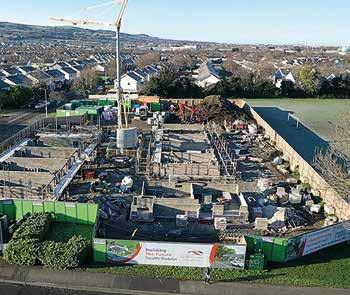
removing barriers to physical spaces. To this end, Brady’s Court is secure with controlled access but barrier-free within the space, with spaces and buildings configured and constructed to remove physical obstacles for people with mobility issues, ensuring accessibility for everyone. From a universal accessibility perspective, spaces are usable by all people, regardless of physical or sensory abilities.
The development has inclusive features such as ramps instead of stairs, wide doorways for wheelchair access, and tactile surfaces for the visually impaired.
While traditional fire safety designs utilise lobbies and vestibules

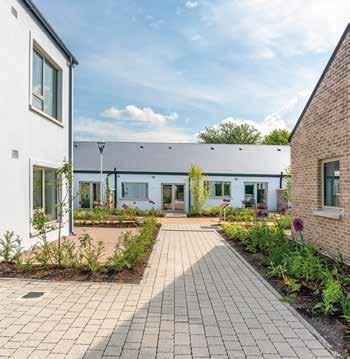
as fire and smoke barriers, these spaces can pose significant navigational challenges for individuals with disabilities, especially during emergencies. To mitigate this, residential units in Brady’s Court feature direct courtyard exits, minimising the need for complex lobbies. This streamlined approach ensures quicker and more accessible evacuation for all, particularly those with mobility impairments.
Community-planted spaces offer residents a place to connect with nature and engage in physical activity. These shared spaces foster social interaction, reducing feelings of isolation for older people and promoting community.
The therapeutic benefits of being around these spaces include improving mental health and wellbeing, while the physical activity involved can contribute to overall health and fitness.
The community spaces around Brady’s Court are biodiverserich, strategically planted with native pollinators, such as Acers, Hydrangeas and Lilacs. The spaces are also furnished with benches and perches for people to gather.
The soft and permeable plant beds assist in the management of surface water.
The community has automated gates to provide security for residents, and there is a mix of secure parking and accessible spaces on the edge of Brady’s Court.
To ensure accessibility and safety, the courtyard design prioritises clear sightlines and efficient circulation. Exits, pathways, and emergency information are visible from all points through strategic signage, colour-coding, and lighting. Obstructions are minimised to guarantee unobstructed views, aiding all residents, particularly those with disabilities, in navigating the space. Dual-aspect apartments enhance natural light, improving overall visibility and evacuation efficiency.
Brady’s Court represents more than just a housing development. It delivers energy-efficient, sustainable homes in a thoughtfully designed environment, fostering a sense of community and independence for its residents. ClearyDoyle has not only met the client’s brief but exceeded expectations, creating a space where residents can thrive in a secure and supportive setting.
Client: South Dublin County Council
Architect/ER/PSDP/Assigned Certifier: O’BF A
Main Contractor: ClearyDoyle
Civil & Structural Engineer: McMahon Associates
Quantity Surveyor: Levins Associates
Building Services Engineer: Healy Consulting Engineers
Landscape Architects: Ait Urbanism and Landscape
HOURS WORKED AND KEY HEALTH & SAFETY STATISTICS
Hours Worked: 179,000
Time Incidents: 0
First Aid Treatments: 0
Near Misses: 0
Project Start Date: August 2022
Project Completion Date: May 2024
Peak Site Labour: January 2024
Building Energy Rating: A1

- Innovative Design
- Exceptional Performance
- Ultra-Low Noise Levels
- Outputs from 4kW – 16kW


Continuing to lead the way in heating technology, Grant has received recognition for Outstanding Innovation for its newly launched Grant Aerona R290 air source heat pump. The award was given to Grant at the recent Plumbing & Heating Awards.
Designed in Ireland to meet the specific demands of the Irish and UK climates, the next-generation Grant Aerona R290 stood out for its innovative design and exceptional efficiency. This cutting-edge addition to Grant’s product portfolio underscores the company’s dedication to offering sustainable and advanced home heating solutions.
During the extensive research and development process, Grant invested heavily in the design and rigorous testing of the new heat pump range, ensuring optimal performance in varying weather conditions across Ireland and the UK. The awards judging panel commended the Aerona R290 for “redefining heating innovation and sustainability,” and said it “sets a new benchmark for low-carbon heating.”
In addition to its impressive technical capabilities, the Aerona R290 features an attractive design and uses the ecofriendly refrigerant R290, which boasts an exceptionally low Global Warming
Potential (GWP) of 3 - marking a significant step forward in environmentally friendly heating technology.
Designed to cater to a wide variety of properties, the A+++ rated Aerona R290 delivers top-tier performance with ultra-quiet operation, a feature acknowledged by the internationally acclaimed Quiet Mark. Additionally, the range can be remotely monitored and controlled through the Grant Aerona Smart Controller, offering enhanced convenience for both homeowners and installers.

Grant Aerona R290 4kW air source heat pump.
The Aerona R290 line includes five models, ranging from 4kW - 16kW which are all available to order through Grant merchants now.
Commenting on the award win, Barry Gorman, National Renewable Sales Manager at Grant, who accepted the award on behalf of the company, stated: “We are thrilled to receive this recognition for the Grant Aerona R290 air source heat pump range. The Grant Aerona R290 air source heat pump will deliver exceptional performance and using the highly energy efficient refrigerant R290 will provide an even more environmentally friendly, low carbon heating solution for homeowners throughout the island of Ireland.”

Alongside the new Aerona R290 heat pump range, Grant has also launched the Aerona Smart Controller. Offering an intuitive solution to control the Grant Aerona R290 heat pump, the Aerona Smart Controller cleverly incorporates sophisticated controller technology with modern and stylish display.
The Aerona Smart Controller is easy to navigate with user friendly controls, designed to make controlling a heat pump system simple and straightforward and allowing a homeowner to set heating schedules, domestic hot water timings and adjust room temperatures to suit preferences.
Supplied with the Aerona Wi-Fi hub, this enables remote access to the Smart Controller’s operation for both the installer and homeowner to analyse system performance data and for the installer to assist with diagnostics.
Both the Aerona R290 heat pump and the Aerona Smart Controller feature within Grant’s integrated heating package solutions, providing further choices and flexibility for design and installation whilst providing the same quality and reliability expected from a Grant heating system.
Visit www.grant.ie more information on Grant’s range of innovative heating solutions. Follow Grant on Facebook @GrantIRL, X and Instagram @grant irl and LinkedIn @ GrantEngineeringULC
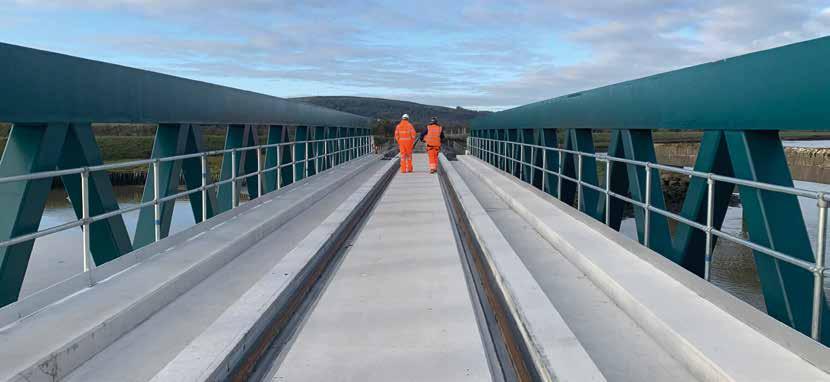
Sisk completes track laying and the next phase of works commences on the Limerick to Foynes Freight line
Iarnród Éireann (Irish Rail) is a step closer to reintroducing freight services on the Limerick to Foynes rail line, as the laying of 42km of new track is now complete.
During the past 27 months, Iarnród Éireann, along with project partner Sisk, has completed the removal of all original rail line infrastructure, followed by a complete renewal and relaying of 42km of track, sleepers and track bed.
Other key elements undertaken by this €151.5m project to date include:
• The removal, restoration and reinstatement of the River Maigue and River Deel bridges
• Construction of a new 46m span bridge to replace Robertstown Viaduct
• The upgrading and reinstatement of 13 public road level crossings
• Installation of duct and drainage routes
• Renewal of user worked level crossings
• Boundary fencing works as required along the length of the line
The line is planned to come into operation in 2026. The project now enters its next phase with works to be undertaken over the next 18 months, including:
• Specialist in-house teams will deliver the signalling and

telecoms infrastructure to enable trains to operate over the line
• Closure of user-worked level crossings by structures
• Refurbishment of Foynes Station building
• Installation and testing of CCTV at the 13 public road level crossings, a significant safety improvement over previous gated crossings
Jim Meade, CEO, Iarnród Éireann, said: “The reinstatement of the freight line between Limerick and Foynes is essential to building freight transportation connections and providing opportunity for businesses to switch from road freight to more sustainable rail freight in the future. This milestone completion of the track laying on the line means we are a step closer to delivering a reliable, frequent and, most importantly, sustainable logistics option for many companies that currently use and will, in the future, use the Port of Foynes.”
Paul Brown, CEO, Sisk, said, “Track laying completion marks another major project milestone for our Infrastructure team, who have made significant progress to date, including the removal, restoration and reinstatement of the River Maigue and River Deel bridges. We would like to thank all our team and track laying partner, Steconfer who have installed 66,000 sleepers and look forward to supporting Iarnród Éireann to deliver the final phase of the project.”


Wavin is a market leader in Ireland of solutions and systems for sewer, soil and waste, rainwater, stormwater management (SUDs) and indoor climate. Wavin’s project expertise, hands-on experience, and proven product range give peace of mind to specifiers and installers looking for ‘rightfirst-time’ solutions for complex project requirements.
With over 65 years of experience working with complex projects in the built environment, Wavin has a sizable knowledge bank of practical expertise, regulatory awareness and technical insight to draw from. This delivers invaluable customer support in the form of application suggestions, risk reduction and real cost savings.
When it comes to commercial and multi-residential construction; risk, cost and complexity all increase along with the physical scale of the build. It’s in these large commercial projects that contractors and specifiers profit from the product benefits in the design, function, installation, efficiency and performance of a system. Wavin soil, waste and plumbing systems have been scaled to meet these challenges. Designed to speed up installation, reduce noise and guarantee performance, thereby reducing risk and efficiently managing water and waste from roof to ground, the portfolio, which includes AS+ Low Noise soil, HDPE Soil, Compact Soil and Grey PVC-U Soil systems, also offers end to end support including application suggestion and BIM packages.
The Wavin Grey PVC-U Soil range was the system of choice on recent commercial projects in Galway and Dublin. Brickfield Square in Dublin 12 is a multi-use, state-of-the-art community

residential development that runs across four blocks and ranges between four and 10 storeys, while the Crown Square Hotel in Galway City is a 177-bedroom hotel built to Lean Construction Philosophy. The quality of Wavin’s systems with third-party certification and reliability of supply, along with technical support, were key factors in the system selection for the M&E contractors.
Wavin Grey PVC-U Soil delivers a wide range of pipes and fittings in 82, 110 and 160mm sizes, including brackets, bends, junctions, access fittings, and terminations. Pipes are manufactured with Wavin Recycore technology, incorporating over 50% recycled content to provide a sustainable solution.
To aid installation, fittings feature a unique keyway which mitigates risk by ‘locking-in’ a 2.5° fall on waste pipes to ensure soil stack joints comply with EN 12056. In addition, innovative captive seals, co-moulded to the cap of couplers cannot be dislodged in installation. Specialist fittings, such as the six-way compact manifold option, give maximum flexibility for waste connections.
John McPeake, Technical Sales Manager (B ENG MIEI), Wavin Ireland, comments, “Architects, engineers and contractors select Wavin product systems for numerous reasons; our project-focused philosophy and the guaranteed quality and solutions driven emphasis we place on our systems. But it’s more than that; it’s also the reliable technical know-how of our team and the on-site advice available to specifiers and installers that delivers additional peace of mind on these large-scale developments.”
To see how the Wavin technical team can help with your next project, email projects. ie@wavin.com or scan the QR code


Ireland’s housing crisis deepened in 2024 with fewer homes built, hindered by planning, infrastructure, and zoning issues despite builders’ readiness to deliver. CONOR
O’CONNELL, Director, Housing & Planning, Construction Industry Federation, outlines issues that need to be addressed to remove obstacles to housing delivery.
The issue of housing supply was recently brought into sharp focus as we constructed less homes in 2024 than 2023.
Questions were asked about how could the projections be so wrong and who was at fault. As usual, housing supply became a political football with lots of commentary and finger-waving.
The housing crisis is the central issue of our time. While debates and commentary persist, there are thousands of people waiting to buy homes or access social housing. Despite this urgent need for housing, an increasing number of roadblocks, such as planning delays, water and electricity shortages, and land zoning challenges, have created a homebuilding crisis within the broader housing crisis at a time when new homes are needed more than ever.
Building more homes depends on four key issues,
• Zoned residential land
• Services and infrastructure availability, such as water and electricity connections,
• Planning permission and
• Financial viability and funding
All of these are essential components of homebuilding, yet they are heavily constrained.
You cannot just build anywhere. Not only do you have to seek planning permission, but the place or location you wish to build in has to be zoned for that purpose in a county development plan by your local authority. The local authority specifies how much land is to be zoned for residential development based on population projections decided at a national level.
The last time our population growth was estimated in detail for assessing the amount of land that could be zoned for housing was in the 2018 National Planning Framework. This was based on population growth estimates from the 2016 census.
Since 2016, our population has grown far in excess of the estimate from this time. As you can imagine, this has constrained the supply of zoned land, prices have risen, and availability has become scarce. What’s more, land designated for housing can lose its zoning status once the local area plan expires.
The solution? Local authorities must be instructed by the government to zone more land for housing and to keep the current zoning active by not allowing zoned land to become dezoned as a result of local plans expiring.

Land availability cannot be addressed in isolation; it must be considered alongside the availability and supply of water and wastewater infrastructure, road and public transport access, electricity supply and, of course, supporting community infrastructure.
Investing in infrastructure is not a cost but a public investment in

our future. We not only need zoned land in the right locations, but also ‘pipes in the ground’ to supply water to new homes. Similar, to the supply of zoned land, the government has been consistently underestimating the amount of infrastructural investment required. In some years, funding allocated in the Public Capital Programme, hasn’t been spent.
Planning has undergone significant changes in recent years with a new Planning and Development Act, Compact Growth Guidelines to guide efficient land use for housing, and the revision of the National Planning Framework, the state’s overarching blueprint for planning.
Yet, delays in the planning system persist, highlighting the need for much stricter enforcement of decision-making timeframes to accelerate house building for the many people urgently in need of homes.
Home builders in Ireland are committed and ready to construct the homes desperately needed by those caught in the housing crisis and play a crucial role in addressing the backlog. As those on the ground, home builders experience first-hand the practical challenges of getting a housing development started and understand the obstacles for what they truly are. The process of building a home is the simplest part of the puzzle. We urgently need action, and we hope that the government will provide that momentum.
In short, housebuilders are ready to build more.
Conor O’Connell is the Housing, Planning & Development Director with the Construction Industry Federation. He is also Secretary of the CIF Regional Development Committee and is responsible for the development of CIF Regional Development Policy as well as stakeholder engagement on construction policy issues across government departments, semi-state agencies, local authorities, politicians and various regional bodies. He was previously the CIF Southern Region Director.
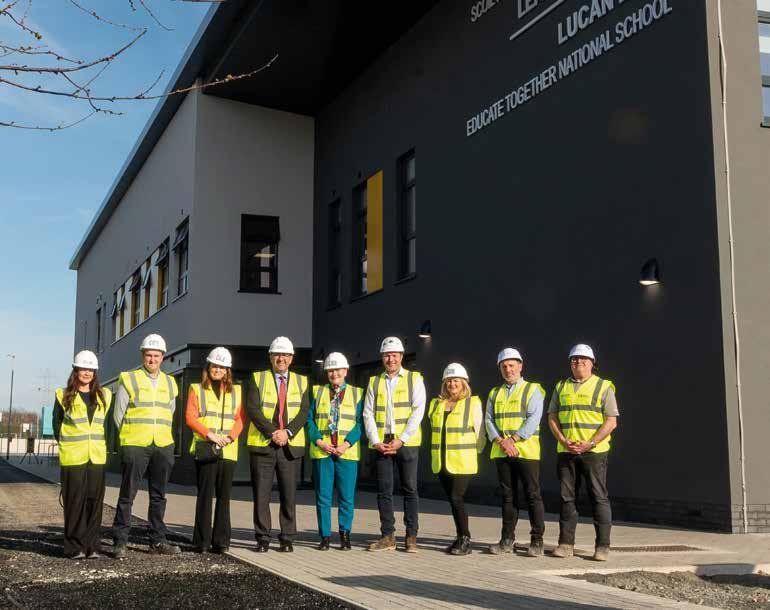
Visiting Ireland’s first permanent modular school, Lucan East Educate Together, by CPAC Modular. (L to r): Alexa Buso, CIOB Member Services and Events Coordinator; Dermot Fitzgerald, CIOB Committee Vice-Chair; Sarah Hallinan, CIOB Regional Manager; Mike Kagioglou, CIOB President; Caroline Gumble, CEO, CIOB; Mark Whitehead, Construction Director, CPAC Modular Construction; Annette Main, CIOB Committee Chair; Gavin Fox, Head of Business Development, CPAC Modular; Alan Boyce, Senior Marketing Manager, CPAC Modular.
CAROLINE GUMBLE, CEO, CIOB, writes about her recent visit to Ireland when she visited the new National Children’s Hospital and Ireland’s first permanent modular school, which CPAC Modular delivered.
Recently, I was warmly welcomed to Dublin along with CIOB President Professor Mike Kagioglou FCIOB to meet with some of our members and see some of the region’s companies in action.
For our first stop of the visit, we were invited to see the new National Children’s Hospital, a site visit that was facilitated by BAM UK & Ireland. I’m sure readers will be aware that this project is one of the most significant capital projects in the country. Although it’s not been without controversy, it is an ambitious undertaking which includes state-of-the-art paediatric care facilities. We were taken on a guided tour of some of these, and I was deeply impressed by the attention to detail for the needs of the patients and their parents and carers. It was also evident that a great deal of thought has gone into work to try and future-proof the facilities.
I know there have been opportunities for regeneration of the area, with the site for the main building being a “redundant” part of the hospital campus. I also want to applaud the support for apprentices as part of the development – investing in construction professionals
of the future is one way to help close the skills gap and benefit the wider industry.
I want to thank the BAM Ireland team for their time, for sharing the knowledge they’ve gained during the project and for their

commitment to ongoing learning and professional development.
In fact, BAM Ireland is one of CIOB’s Training Partner companies. Our Training Partnerships are a free service offered by CIOB where individual plans are created for your employees, with advice on the most suitable routes towards becoming a chartered professional. This is something we do as a mechanism to support individuals, companies and the wider industry – we believe it’s part of our work to promote best practice and help to set standards across the industry, with construction professionals evidencing competence.
Our second visit of the day took us from a hospital to a school, with a visit to a new school site courtesy of CPAC Modular, which has delivered this project as Ireland’s first permanent modular school. This development is an excellent example of innovation, showing how a more sustainable approach can be delivered with modular construction. It was useful to have conversations with practitioners about more sustainable materials and the potential for improvements in efficiency.
The arguments around more use of modular construction have been made before – it can offer solutions for a variety of building types, the quality is high, there are possibilities to speed up the process, it can be more sustainable, and there are ways in which it can remove some health and safety risks.
Proponents of modular construction sum up the case by saying it has the potential to increase supply and deliver a supply that has a lower level of embodied carbon.
In fact, last year, CIOB and the Think-tank for Action on Social Change (TASC) published a report focusing on Irish housing, which looks at whether or not modern methods of construction (MMC) can provide solutions. (The ‘Modern Methods of Construction: barriers and benefits for Irish housing’ report is available on the CIOB website and featured in ‘Irish Construction News’ last year.)
Projects such as this school are where the theory becomes practice, and it is good to see it completed. However, it will be put to the ultimate test as the school is welcoming their first intake soon.
Thank you to Mark Whitehead and his team for the time and for sharing their knowledge and insights.
I must also take this opportunity to thank Annette McElligott Main, Chair of our Republic of Ireland Hub, and Dermot Fitzgerald MCIOB, our Hub Vice Chair, for joining the CIOB President and me for a busy day. It was a wonderful opportunity to catch up and hear their industry updates and learn about all the good work CIOB members are doing in Ireland.
To learn more about the Chartered Institute of Building and the work of its Republic of Ireland Hub, visit www.ciob.org
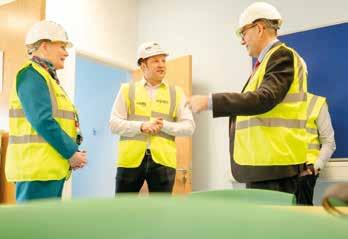
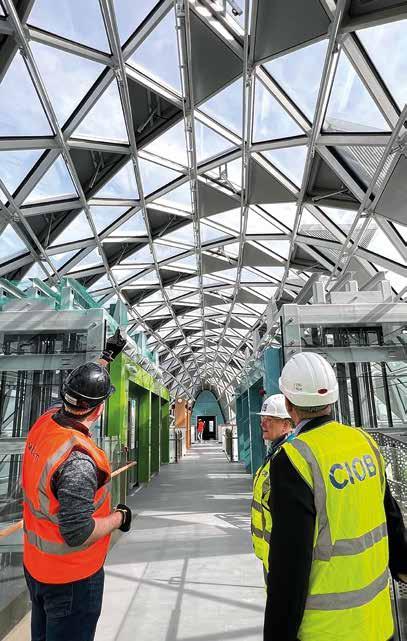
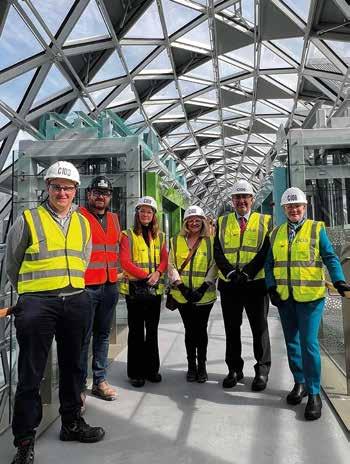
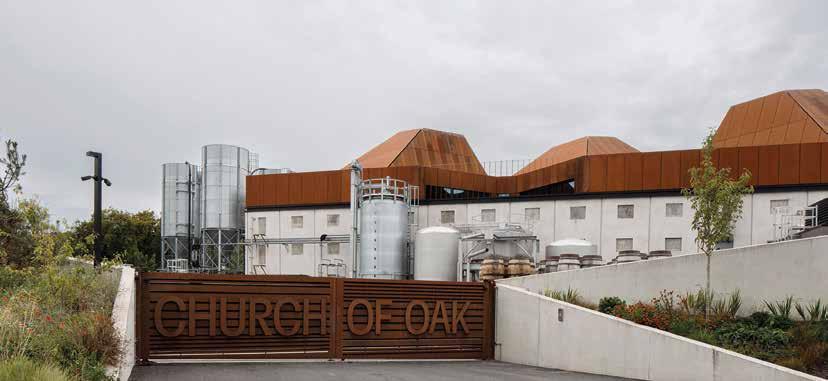
Building
Excellence in concrete design and construction was celebrated at the Irish Concrete Society’s Awards, which took place on 29 March in the Clayton Hotel, Burlington Road, Dublin.
This was the Irish Concrete Society’s 42nd annual awards evening and with over 270 in attendance, is always one of the highlights of the construction industry’s calendar. Adjudicated by a distinguished, independent jury of industry professionals, the awards recognise concrete design and
construction excellence.
The main awards jury reviewed 26 projects nominated in three categories of ‘Infrastructure’, ‘Element’ and ‘Building’. Sponsored by Enterprise Ireland, nine projects were also nominated for the 12th International Award. In addition, the annual Sean de Courcy Student Award winner was announced from three entries and the biennial Sculpture Award was chosen from four entries.
Speaking at the awards evening, Robert Laird, Chair, Irish Concrete Society, stated, “Now being held for the 42nd time, our awards are a chance to showcase the high calibre of concrete execution in Ireland and by Irish companies abroad. On behalf of the society, I would like to thank all jury members who gave their time and expertise to pick the winners in each category. While this evening we honour these winners in particular, I would like to pay tribute to all

who entered into the competitions. These entries showcase the excellence which continues to be achieved in the use of concrete in Ireland.”
The main awards jury consisted of Steven Connoly (Grafton Architects) and Pauraic Matthews (CSEA), and it was chaired by Adrian Cunningham (BAM Ireland).
Client: Jewelfield
Architect: ODOS
Engineer: JJ Campbell & Associates
Contractor: Ormonde Construction
Major Supplier: Kilsaran
The Church of Oak Distillery was chosen as the Overall Award winner from 14 Building Category and 26 other entries. The judges’ commendation stated: “The Church of Oak Distillery stands as a landmark restoration and adaptive reuse of the historic Ballykelly Mills, positioned along the Grand Canal in Monasterevin, Co Kildare. This transformation exemplifies a sensitive balance between contemporary sustainable construction and the preservation of the site’s rich industrial heritage.
“The design approach carefully integrates modern interventions within the existing fabric, with concrete playing a pivotal role in both structural performance and architectural expression. The project showcases a refined palette of concrete finishes, demonstrating exceptional craftsmanship while reinforcing the authenticity of the historic structure.
Element Category Winner: Roscommon Covered Space.
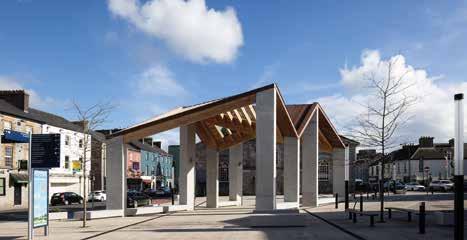

Infrastructure Category Winner: Ulster Canal Restoration ProjectPhase 2, Clonfad Syphon, Aqueduct and Bridge.

12th International Award Winner: Everton Stadium, Liverpool.
The jury particularly noted the seamless integration of concrete in preserving original building elements, ensuring continuity between past and present.
CATEGORY WINNER: ULSTER CANAL RESTORATION PROJECT
- Phase 2, Clonfad Syphon, Aqueduct and Bridge
Client: Waterways Ireland
Engineer and Designer: DBFL Consulting Engineers
Engineer: Doran Consulting
Contractor: Jons Civil Engineering
Major Suppliers: Banagher Precast Concrete/Shay Murtagh Precast/Wright Quarry Products
The Ulster Canal Restoration Project
- Phase 2 was chosen from five entered
projects. The jury’s commendation stated: “What sets this project apart from the others is the varied concrete forms used in the restoration of the canal and how well it sits back into the local environment. The syphon structure is unique, set against the backdrop of a tight site on difficult terrain. Another feature of the project was the use of offsite construction, where and arched mould for the construction of the bridge beams on the Clonfad bridge was used.
“An excellent example of the adaptability of concrete and its use in blending into the surrounding structures. It demonstrates the collaboration between designers and contractors in meeting a project’s goal.”
Client: Roscommon County Council
Architect: GKMP Architects
Engineer: Brunner Consulting Engineers
Contractor: Pat Loftus Construction Group
Major Supplier: Urbancrete
Chosen from a total of seven entries, the jury commendation for Roscommon Covered Space stated: “The project involves the design of a Covered Space and Historic Well in the Market Square, Roscommon Town. The project is a leading example of a real, open, sustainable realm where the community can use and enjoy it.
“The use of material and craftsmanship were exemplary. The jury was impressed with the level of finish achieved on the polished concrete incorporating the clean lines on the column supports and the detail of the roof tying into the concrete.”
Client: Everton Football Club, Liverpool, UK
Irish Export Company: Banagher Precast Concrete
The jury commendation Banagher Precast Concrete’s Everton Stadium award stated: “The innovative design of the double terracing units overcame multiple technical challenges to have wide-ranging positive effects on the programme, budget and most importantly a significantly positive effect on the sustainable design approach of the project.”
AWARD: ‘ARCHIVING HOPE’ BY FIONA HAYES
This biennial Award Scheme enables the Society to acknowledge the work of artists who use concrete as a medium of expression in sculpture. The jury consisted of Elizabeth Shotten (Architect) and Ken Lambert (Artist).
This annual award is given to the best project on a concrete-related topic from accredited masters and degree programmes in Civil and Structural engineering faculties of Higher Education Institutes on the island of Ireland.
The award is named after the late Professor Sean de Courcy, an inspirational professor for many years at UCD, a former chairperson of the Irish Concrete Society, an author and historian of note.
The student award jury comprised the Chair Eoin O’Meara (John Sisk & Son), Aidan Fogarty (Ecocem) and Alan Boyle (Punch Consulting).
Niall Hanratty (University College Dublin) won for his project ‘The Effect of Different Clays on the Properties of LowCarbon 3D Printed Concrete’.
A new ‘Housing Insights’ paper by The Housing Agency examines the progressive steps taken by Dún Laoghaire-Rathdown County Council and its key stakeholders to ensure that infrastructure is plan-led, phased and strategically provided to support Cherrywood’s development.
Cherrywood, upon completion, will be Ireland’s largest SDZ, providing approximately 10,500 new homes for an estimated population of 26,000. This ambitious project, located within Dún Laoghaire-Rathdown County Council’s (DLRCC’s) catchment area, presented unique challenges due to its size and the need to coordinate infrastructure development across multiple landowners.
The most recent ‘Housing Insights’ paper by The Housing Agency highlights how DLRCC and its stakeholders successfully addressed these challenges by adopting a plan-led, phased, and strategic approach to infrastructure provision. This approach emphasises the critical role of physical and social infrastructure in creating sustainable communities.
Physical Infrastructure: Essential for unlocking land development, including:
• Water and drainage systems
• Transportation networks
• Utilities
• Waste management
Social Infrastructure: Crucial for community well-being, encompassing:
• Parks and recreational spaces
• Schools and childcare facilities
• Community amenities
The “10-Minute Neighbourhood” Concept
The Cherrywood development is designed around the ‘10-minute neighbourhood’ concept, an adaptation of the ‘15-minute city’ model. This aims to ensure that residents can access essential services and amenities within a 10-minute walk or cycle, reducing car dependency and promoting sustainable living.
Cherrywood implements this concept through the strategic placement of public parks, playing fields, active travel routes, schools, employment spaces, and village centres.
DLRCC’s successful infrastructure delivery was attributed to four key actions:
• Dedicated Multi-Disciplinary Team:
Establishing a specialised team to manage the complex project
• Phasing and Sequencing of Infrastructure Provision: Prioritising and coordinating infrastructure development alongside housing construction.
• Collaboration and Early Engagement with Multiple Stakeholders: Fostering cooperation among landowners, developers, and community members.
• Utilising Various Funding Streams: Securing diverse financial resources to support infrastructure projects.
The Cherrywood SDZ continues to evolve, with DLRCC proactively implementing planning scheme amendments to address changing needs and opportunities. Future plans include the potential addition of 2,000 residential units in the Town Centre and the creation of 22,000 new jobs. The development will feature a mixed-use Town Centre and three Village Centres, connected by public transport, including five Luas (light rail) stops and pedestrian/cycle-friendly greenways.
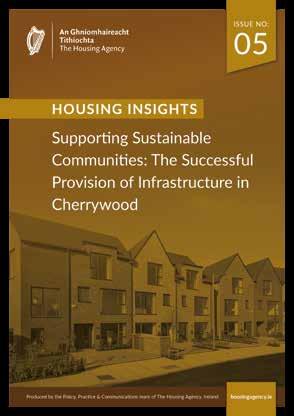
Cherrywood serves as a model for plan-led, integrated urban development in Ireland. Strategic phasing and sequencing of physical and social infrastructure are crucial for creating sustainable communities.
The 10-minute neighbourhood concept is being implemented to provide easy access for residents to daily needs.
DLRCC’s proactive approach, including ongoing planning scheme reviews, has been instrumental in the project’s success.
The lessons learned from Cherrywood will inform future housing developments in Ireland, emphasising the importance of sustainable community planning.
To download this Housing Insights issue and other Housing Agency publications and resources, visit www.housingagency.ie/publications
The Housing Agency is a government body working with the Department of Housing, Local Government and Heritage, local authorities and approved housing bodies to deliver housing and housing services. The agency’s vision is to achieve an integrated housing system that meets the nation’s housing needs and promotes sustainable communities. It does this by providing evidencebased housing insights and data that inform thinking and policy-making, by working with others to enable the delivery of housing solutions and to implement programmes and actions in the government housing policy, and by equipping itself and its stakeholders with the capacity required to respond quickly and effectively to challenges in the housing system.
The Housing Agency Housing Insight series aims to disseminate good practice in housing and innovative solutions among housing practitioners in Ireland.
The Irish Planning Institute has announced that the 2025 Irish Planning Awards are now open for entries. The biennial Irish Planning Awards recognise and celebrate outstanding achievements in the planning profession, including projects and plans at local, county, regional and national levels.
The awards aim to promote excellence in the field of planning, encourage sustainable development, foster positive engagement between communities and projects, support economic development through thoughtful planning and honour projects that conserve historical buildings or create cultural venues. Most importantly, the Irish Planning Awards are designed to inspire innovation throughout the planning sector.
The 2025 Irish Planning Awards, which are supported by FuturEnergy Ireland, Uisce Éireann and Wave Dynamics Acoustic Consultants, will recognise planning excellence across 12 diverse categories, including:
• Plan Making
• Commercial Projects
• Urban Regeneration
• Heritage and Culture
• Climate Action

The Eastern and Midland Regional Assembly were joint winners of the IPI Planning Awards 2023 under the Research and Innovation category for the Regional Development Monitor.
• Biodiversity
• Housing or Community
• Infrastructure
• Research and Innovation
• Diversity and Inclusion
• Planning Consultancy and In-House Planning Teams
• Planning Authorities
An overall President’s Award will be awarded to the standout winner across all 12 categories. The awards are open to members of the professional planning industry for any project undertaken since January 2023 or completed within the last five years.
Gavin Lawlor, President of the Irish
Planning Institute, said: “I’m delighted to announce that the 2025 Irish Planning Awards are now open to entries. Similar to previous years, we look forward to receiving a broad range of submissions and entries, which demonstrate excellence in the planning profession.”
The closing date for submissions to the 2025 Irish Planning Awards is 5 PM on Friday, 30 May. A panel of expert judges will shortlist entries before the awards night on Thursday, 25 September 2025, at Clontarf Castle Hotel, Dublin.
For more details, visit www.ipi.ie
The London-based Association for Project Management (APM), the chartered body for the project management profession, has announced the establishment of a regional network in the Republic of Ireland. This significant expansion reflects APM’s ongoing commitment to international growth and follows the successful launch of a new regional network in Dubai, UAE, in recent weeks.
APM’s Regional Network will support growth and professional development in Ireland through a range of events and activities, including continuing professional development (CPD) workshops, networking events and conferences, as well as hosting volunteer opportunities that support specific focus areas like education outreach, corporate engagement, and emerging professional activities. APM is partnering with leading companies and organisations across industries such as finance, IT, construction and pharma to drive engagement and facilitate knowledge sharing to strengthen industry collaboration in Ireland
Professor Adam Boddison, CEO, APM, stated: “We are delighted to launch our Regional Network in Ireland, making it easier for project management professionals here to broaden and deepen their skills in the sector and to achieve chartered status within the profession. Using our knowledge and experience, combined with key stakeholders in the country, we will also look to collaborate at a government level to ensure that chartership is a mandated standard on significant public projects, thus improving the overall process and contributing to more successful project completions.”
Anthony McCarthy, Director, Cogent Associates, will lead the Ireland Regional Network, supported by Deputy Lead Ricardo Santos, Programme Manager, Iarnród Éireann.
Anthony McCarthy commented, “Project management, in its
many forms, in Ireland is going from strength to strength and offers a varied and rewarding career for professionals across a broad swathe of sectors. Ricardo and I are excited about playing our part with the Irish Regional Network of the APM in contributing to and developing ever higher professional standards within the project management sector in Ireland.”
With over 50 years of expertise in developing and applying best practice to the project management sector, the APM is at the forefront of the latest developments in project management theory and practice.
To find out more about the APM, email volunteers@apm.org.uk or visit apm.org.uk/community/republic-of-ireland-network/
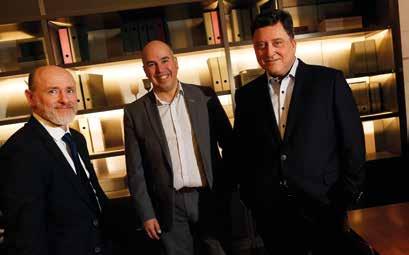
at the launch of
Leading fire protection specialists
Automatic Fire has announced the appointment of Ray Greene to its board as operations director.
A company release noted the appointment is a significant step in its strategic development and ongoing commitment to excellence.
Ray Greene brings over three decades of experience in the Irish and European fire protection industry. With expertise in operations management, strategic planning, and project leadership, he has built a reputation for optimising processes, improving efficiency, and driving growth across the sector. His knowledge and leadership are invaluable assets as we continue to innovate and deliver outstanding service to our clients.
Holding diplomas in Project Management (Trinity College) and Lean Quality Systems (University of Limerick), Ray Greene is dedicated to fostering a culture of continuous improvement and delivering innovative
solutions that meet the ever-evolving needs of clients.
Paul Kennedy, Managing Director, Automatic Fire, commented, “We are excited to welcome Ray to the team. His experience and leadership will be crucial as we continue to grow and enhance our operations. We look forward to seeing the positive impact he will have.”
Ray Greene commented: “I’m thrilled to join Automatic Fire at such an exciting time. I look forward to collaborating with the team to drive innovation and deliver top-quality solutions for our clients.”
Automatic Fire is a leading provider of fire protection systems, specialising in sprinkler, gas suppression and fire alarm installation and maintenance for a wide range of industries. With a commitment to excellence and innovation, the company ensures the highest safety and service standards for its clients across Ireland and Europe.

The Association of Plumbing and Heating Contractors of Ireland (APHCI) is undergoing a significant restructuring to amplify its national presence and influence within the industry. This move coincides with the appointment of David Gilroy as the new Chief Executive Officer (CEO) and the establishment of a crucial strategic partnership. Gilroy brings extensive experience in the sustainability and energy
sectors and will lead APHCI through its next phase of growth, innovation, and memberfocused development.
The announcement was made at the SEAI Energy Show in the RDS, Dublin, where David Gilroy was joined by John Reynolds, Patrick Jordan and Ken Lawrence, members of the APHCI board of directors.
During the event, David Gilroy and the APHCI directors met with Minister for

Climate, Environment and Energy and Minister for Transport Darragh O’Brien and SEAI CEO William Walsh to highlight the critical role of skilled plumbing and heating contractors in meeting Ireland’s retrofit and decarbonisation targets.
APHCI also announced a new strategic partnership with UpperCross Enterprise Limited (UEL), a significant development for the sector. The collaboration aims to support members with access to advanced commercial solutions, training, and product innovation. UEL Sales Director Niall Fitzgerald joined the APHCI team at the Energy Show to highlight the shared vision of upskilling the workforce and supporting best-in-class sustainable practices.
David Gilroy commented: “This is an exciting time for APHCI and the wider plumbing, heating and renewables community. Our restructuring, combined with new strategic partnerships, places us in a strong position to lead, advocate, and empower our members as we collectively work toward a low-carbon future.”
To learn more about the APHCI, visit www.aphci.ie/
Bretland Construction, a leading construction company headquartered in Edenderry, Co Offaly, has completed a management buyout (MBO), marking an exciting new chapter in the company’s growth and development.
Established in 1999 by founders Fechin and Mary Daly, Bretland Construction has evolved into one of Ireland’s most trusted construction firms, renowned for delivering high-quality projects ranging from bespoke residential homes to complex commercial and industrial developments across Ireland.
The MBO signifies the exit of Fechin and Mary Daly. The company will continue under the leadership of current board members: Coleman Yates, Managing Director; Anne Marie McCormack, Operations Director; Tony Meehan, Commercial Director; and Ruth Heeney, Finance Director.
Commenting on the transition, Coleman Yates said, “We are delighted to have completed this significant milestone and are genuinely excited about the opportunities ahead. Bretland Construction has always thrived on a foundation built of integrity, excellence, and teamwork. We are committed to continuing this tradition of delivering exceptional results for our clients. On behalf of our entire management team, I want to sincerely thank Fechin and Mary Daly for their unwavering support, mentorship, and trust over the years. Their legacy will be honoured as we embark on our next chapter of growth and innovation.”
Yates added, “This MBO marks a major turning point for Bretland Construction and our dedicated employees. Just as every successful building project starts with meticulous planning and solid foundations, our continued success will be based on our experienced and passionate team. Our vision is clear: to lead the

Bretland Construction directors (l to r): Coleman Yates (Managing Director), Anne Marie McCormack (Operations Director), Ruth Heeney (Finance Director), and Tony Meehan (Commercial Director).
industry by upholding the highest standards in quality, safety, and sustainability. I extend my heartfelt thanks to every team member whose hard work and dedication have made this milestone possible.”
Advisors assisting Bretland in this significant transition included Ross Little, Partner of Byrne Wallace Shields LLP, Owen Travers, Lender Advisor of Interpath Advisory, Derek Dervan in Valuation Tax from UHY Farrelly Dawe White, and Philip Carey, Business Banking Manager, PTSB.
Bretland Construction is recognised for its commitment to excellence, emphasising sustainable building practices and rigorous safety standards that ensure responsible and enduring construction.
EcoVerify has made global history by becoming the first organisation in the world accredited to verify carbon neutrality claims under ISO 14068-1 and to validate and verify Net Zero Pathwayssetting a new international benchmark in climate assurance.
The accreditation was granted by the Dutch Accreditation Council (RvA). This national body assesses and monitors the competence of conformity assessment organisations, including laboratories, inspection bodies, certification bodies, and verification/validation bodies.
In addition, EcoVerify is now the first Irish-owned firm accredited under EN ISO 17029 to independently verify carbon footprints, carbon neutrality, and Net Zero claims, reinforcing Ireland’s leadership in credible climate action and transparency.
EcoVerify has been recognised as a provider of high-assurance sustainability verification, delivering trusted compliance solutions aligned with global best practices for SMEs.
Additionally, it will facilitate expanding the company’s services to include tailored

Laura Mora, Managing Director, EcoVerify.
training and verification programmes for SMEs, empowering them to demonstrate their ESG progress and strengthen their sustainability practices credibly.
Laura Mora, Managing Director, EcoVerify, said: “In a world of shifting regulations and rising ESG scrutiny, verified sustainability is no longer optional—it’s a strategic differentiator. Sustainability isn’t just for the big players. SMEs verified today
are tomorrow’s preferred suppliers. We are therefore delighted to achieve the Raad Voor certification, which ensures that the confidence in the quality of services we offer to the market is fully justified.”
EcoVerify has rapidly become the market leader in combating greenwashing since its launch in 2023. Its advancement coincides with the increased number of global sustainability disclosures that are required of businesses to meet in an ever-changing political landscape. This is necessitated through large-scale investor scrutiny, socially conscious clients who desire environmentally responsible suppliers, and the need to ensure consumer confidence in verifiable sustainability claims.
With a team of specialists in carbon footprint management, Net Zero pathways, life cycle assessment, sustainability reporting assurance, and international standards, EcoVerify provides SMEs with tailored verification, carbon footprint and Net Zero training, and gradual compliance strategies to secure their future competitiveness across supply chains, financing, and customer relations.

COWI, a leading international engineering consulting group, has announced the opening of a new office in Dublin to provide critical engineering expertise to support Project Ireland 2040,
The new office will house a hybrid team of Irish, Danish, and other specialists from across the globe, combining local talent with international expertise to support the National Development Plan.
COWI aims to get to 50 staff within three years, establishing a Centre of Excellence that fosters innovation and attracts the next generation of engineers. The team of engineering experts will support both national and international projects, with a key focus on driving Ireland’s green transition.
David Feighery, COWI’s Head of Ireland, comments: “Project Ireland 2040 represents a transformative opportunity for sustainable infrastructure development across the country. As Ireland commits to enhancing regional connectivity, transitioning to renewable
energy, and creating climate-resilient communities, COWI brings proven expertise from similar successful transitions in Denmark and wider Scandinavia. We are already contributing to Ireland’s green transition through our work on the Dublin District Heating Project, which aims to provide sustainable heating to homes and businesses. Our engineering solutions will help Ireland achieve its goals of compact urban growth, enhanced regional accessibility, and the transition to a low-carbon economy.”
The expansion comes as Ireland undergoes an intensive phase of construction and energy transformation. COWI’s experience delivering Copenhagen’s metro system, Denmark’s light rail networks, and offshore wind projects positions the company to play a vital role in helping Ireland achieve its sustainability targets. Denmark is on track to generate 100% of its electricity from renewable sources by 2030, with 82% already achieved in 2023.
Hardware Association Ireland (HAI) recently hosted its annual Hardware Conference at The Heritage Hotel in Killenard, Co Laois, bringing together over 200 key decision-makers from the hardware and building materials sector to discuss the future of hardware retail and builders merchanting stores, emphasising their vital role in housing.
The conference featured speakers that included international experts in hardware retail from the USA, Europe, and the UK, such as Steve Collinge, Greg Fry, Mathias Lönneker, Kieran McCarthy, Gina Schaefer, and Michael Stanley.
Key topics addressed during the conference encompassed:
• Strategies for supporting homeowners, builders, and tradespeople
• Balancing physical retail with e-commerce
• Optimising in-store strategies to enhance customer experience
Commenting on the event, Martin Markey, Chief Executive of HAI, said, “Today’s conference is central to the hardware and construction sector, providing
up-to-the-minute knowledge on trends and insights in a rapidly evolving industry. The exchange of ideas and strategies here will
strengthen our community and drive future success.”

The Utzon Center in Aalborg was the setting for one of the most eagerly anticipated premieres in the world of architecture: ‘Can Lis – Utzon’s Hidden Masterpiece’.
This documentary, produced by Share Your Green Design and supported by the Utzon Center, explores Can Lis, the legacy of Jørn Utzon, the visionary architect behind the iconic Sydney Opera House.
Share Your Green Design is a platform dedicated to connecting and promoting excellence in design and architecture, spreading knowledge about innovative and responsible practices.
Through this production, Share Your Green Design expands its reach, using film as a medium to tell powerful stories about how design can transform the spaces we inhabit and how architectural decisions impact our daily lives. This documentary reinforces its commitment to spreading knowledge and serves as a tool for reflection for all those involved in creating sustainable and responsible spaces.
Directed by Juan Alberto Morillas, a Spanish architect with a notable career in sustainable architecture and founder of Share Your Green Design, this documentary marks his first venture into filmmaking. He is also Head of Sustainable Design at Sisk.
Morillas stated: “In life, there are moments that define us, and for me, visiting Can Lis in 2022 was one of those moments. This documentary is the result of three years of research into Can Lis, Mallorca, and Utzon, but it is also about what is truly important in architecture and life. Can Lis is much more than a house. It is the materialisation of a way of understanding the world. And that is

what I have tried to convey with this documentary.”
The film delves into the history of Can Lis, the residence Utzon designed on the coast of Mallorca. More than just a house, Can Lis represents the perfect harmony between design and nature, using local materials and sustainability principles long before the concept gained global significance.
The documentary was produced by Juan A. Morillas and Mónica Rodríguez (Share Your Green Design) and features Piers Taylor, an English architect and renowned documentary presenter on the BBC and Netflix, who shares his perspective on the significance of Utzon’s work in contemporary architecture.
For more information about the documentary and to watch the trailer, visit https://www.shareyourgreendesign.com
TG4 ‘Na Builders’ covers the on-site drama of constructing in Ireland

There are over 160,000 people employed in the construction industry in Ireland. These people build, renovate and reimagine our countryside and our towns.
‘Na Builders’ is an original, home-grown series for TG4 that shines the spotlight on construction workers across the country as they battle the elements and occasionally each other to get the job done.
The series features builders of all shapes and sizes in rural and urban settings, covering what and who they are building for.
Contractors featured in the series include Townmore, Waterford builder Tom Breathnach, Monaghan-based BuildWright and Westmeath-based Coolsivna Construction Ltd.
‘Off the Fence with Purpose’ is a new podcast series for anyone searching for purpose in their work or contemplating a career change, presented by Jim Walsh, founder and executive chair of Walsh Communications.
Each episode features inspiring guests who share their unique career journeys, reveal the lessons they’ve learned, and offer invaluable advice on turning passion into success.
Guests include Patrick Atkinson, CEO of Chadwicks Group, who discusses his varied career and positions within organisations in the Irish construction sector, including Wavin, Gypsum Industries and Saint-Gobain. Other guests, to date, include Carmel Doyle, CEO of the Oesophageal Cancer Fund; and Ellen Gunning, founder of Mettacomms and the Irish Academy of Public Relations. Off the Fence with Purpose is broadcast every two weeks. Hosted by Acast, it can be found on Apple Podcast and Spotify.
To listen to the latest podcast, visit https://shows.acast.com/off-the-fence-with-purpose
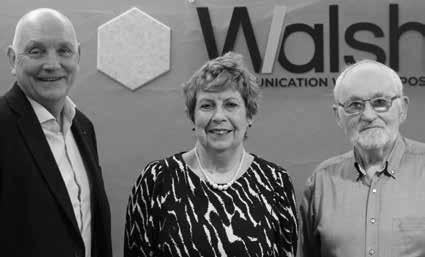
Rockwell has announced the acquisition of Frank McGowan Electrical, a well-established name in the Irish electrical engineering industry. This strategic move brings an exceptional team of electrical professionals with decades of expertise. The move will see a rebrand to Rockwell Electric and enhance Rockwell’s current service offering across Ireland.
Founded in 1981 by Frank McGowan in Athlone, the company quickly became a trusted partner in industrial, commercial, and public works projects across the Midlands. Under the leadership of Michael Boland since 2007, Frank McGowan & Sons entered the pharmaceutical and technology sectors and gained a reputation for excellence in project delivery and client support.
With this acquisition, Rockwell strengthens its capabilities and expands its footprint in the sector. It further supports our ability to deliver M&E projects and decarbonisation solutions to clients, from design to installation and commissioning. The addition of several experienced professionals will enhance Rockwell’s ability to deliver innovative, reliable, and highquality electrical and turnkey solutions.
“This acquisition represents a significant

Pictured (l to r): Michael Boland, Director, Frank McGowan Electrical; Conor Hennessy, Strategy and Development Director, Rockwell; Eddie Quinn, Project Director, Rockwell; John Gleeson (Project Director, Rockwell; and Cathal Walpole, Electrical Construction Manager, Rockwell.
milestone in our growth strategy, further solidifying our leadership position in the industry,” said Garret Murphy, Managing Director, Rockwell. “Our expanded team will allow us to take on even more complex and ambitious projects while maintaining the consistently high standards of safety, quality, and customer satisfaction that our clients expect.”
As part of this acquisition, Rockwell is
also proud to announce the addition of 18 new jobs to its already impressive direct workforce, demonstrating its ongoing commitment to job creation and economic growth. The acquisition aligns with Rockwell’s plans for expansion, particularly in the pharmaceutical and technology sectors, where demand for innovative and reliable engineering solutions remains steady.
Stantec, a global leader in sustainable design and engineering, has acquired Ryan Hanley, a 150-person engineering and environmental consultancy with locations across Ireland.
Ryan Hanley will bring its extensive local knowledge, relationships, and technical expertise to Stantec, particularly around the Irish water sector. The firm delivers a broad range of services, creating solutions for local authorities, government departments, private clients, utility companies, and other influential organisations. The acquisition is integral to Stantec’s goal of expanding its presence in Ireland.
Founded in 1931, Ryan Hanley has offices in Dublin, Galway, Cork, and Castlebar.
Gord Johnston, President and CEO, Stantec, commented, “Through deep and meaningful collaboration, Ryan Hanley and Stantec have proven our ability to deliver outstanding results for clients and communities in Ireland. Innovation and purpose are at the heart of our businesses, and this new chapter is the logical next step in our collective journey. Together, our shared capabilities, expertise, and creativity will help address some of Ireland’s biggest challenges.”
Ryan Hanley has been a local partner for Stantec as part of a successful joint venture (JV) since 2020. The JV has supported Uisce Éireann in its Engineering Design Services Framework helping deliver a €3.5bn investment in asset delivery across its portfolio. The JV was appointed to Uisce Eirean’s Capital Works PMO Services Framework in 2023.
The integration into Stantec will allow Ryan Hanley’s interdisciplinary teams to reach new markets, such as energy, transport, and community development, while drawing from
Stantec’s global footprint and resources.
Ger Gibney, Managing Director, Ryan Hanley, commented, “Over the last 90 years, we have grown to become a values-driven business, founded on passion and integrity as well as doing what is right for communities and the environment. This will not change as Ryan Hanley becomes part of Stantec, a firm that has shown itself to be a hugely valuable partner with an ethos similar to our own. We are all excited for what feels like a natural stage in our evolution as we continue to grow our numbers and drive project excellence across Ireland.”

Coolatee Integrated Constructed Wetlands, a constructed wetland for wastewater treatment in Co Donegal by Ryan Hanley.
Kingspan Insulated Panels is excited to introduce PowerPanel, an integrated roofing and photovoltaic (PV) solution designed for pitched roofs. PowerPanel is one of the first systems globally to earn the FM Approved mark to FM 4478, meeting rigorous performance tests for fire, hail, wind uplift, and snow loading.
This innovative system combines the thermal efficiency of Kingspan’s industryleading QuadCore insulated panels with advanced solar technology, delivering U-values as low as 0.11 W/m²K and energy output up to 475Wp using lightweight dual-glass monocrystalline PV modules from LONGi, a world leader in solar manufacturing.
Manufactured in the UK using stateof-the-art robotics, PowerPanel ensures precision and reduces the risks of on-site installation, blending high performance with a sleek, slimline design to enhance building aesthetics.
For added assurance, PowerPanel includes a comprehensive Kingspan PowerPanel Assured Warranty, covering thermal and

structural performance, external coatings, and photovoltaic modules.
Elevate your building’s performance and appearance with PowerPanel – an efficient, elegant and durable solution.
Sandra Del Bove, Group Head of Innovation at Kingspan, says, “The launch of PowerPanel marks a significant step toward making renewable energy more accessible
to our customers worldwide. Our vision has always been to provide a fully tested and reliable system, ensuring confidence in every installation. This launch is only the first step in what promises to be an inspiring journey ahead.”
For full details please contact IRE: +353 (0) 42 9698 500, or visit www.kingspanpanels.ie

The Minister of State with responsibility for Forestry, Farm Safety and Horticulture, Michael Healy-Rae, TD, has met with the Timber in Construction Steering Group to review progress made over the past year and discuss key emerging recommendations aimed at increasing the use of timber in construction and the built environment.
Minister Healy-Rae said at the meeting: “Ireland has a significant opportunity to expand the use of timber in construction, supporting our climate goals while delivering housing needs. Sustainable timber construction practices will require us to build smarter, higher and safer. The work of this group is vital in identifying the approaches to the wider adoption of timber construction and finding practical solutions. I look forward to the group’s annual report and interim recommendations being brought to Cabinet shortly, setting the course for the next phase of this important work.”
The Timber in Construction Steering Group was established in November 2023 and focuses on five key thematic areas: ‘Market Opportunity’, ‘Regulation and Standards’, ‘Public Procurement and Demonstration Projects’, ‘Research and Development’ and ‘Communication and Education’.
Prof J Owen Lewis. Chair, Timber in Construction Steering Group, added: “With a strong focus on collaboration, the group has already made progress in identifying pathways to increase confidence in timber as a mainstream construction material. Work is ongoing to identify potential markets for increasing the use of timber in both public and private sector construction, thereby decreasing embodied carbon emissions.”
The use of timber in construction is a key element of the Programme for Government, Ireland’s Forest Strategy 2023-2030 and the Climate Action Plan, and of the ongoing effort to develop a sustainable and circular bioeconomy.

ROBBIE COUSINS speaks with Kai Liebetanz, a sustainability expert in nature and resilience and guest speaker at the upcoming IGBC’s Build Green Now 2025 conference, to explore why construction industry stakeholders should factor in embodied ecological impact when evaluating sustainability.
Kai Liebetanz, a sustainability expert in nature, resilience, and the circular economy, has recently been facilitating UK construction sector collaborative working groups at the UK Green Building Council (UKGBC) aimed at developing a better understanding of the embodied ecological impacts of the built environment and to tease out ways in which the sector can address the issue.
Embodied ecological impact concerns the built environment’s relationship with nature. According to the WWF Living Planet Report, there has been an alarming 73% decline in wildlife populations worldwide. “This ecological crisis”, Liebetanz warns, “necessitates understanding the construction sector’s contribution and identifying necessary actions that can be taken.”
He notes that when asked about construction’s impact on nature, responsible stakeholders often cite the necessity of human settlements and point to on-site measures like urban
greening, biodiversity net gain, and green infrastructure. While acknowledging the importance of these local efforts for healthy, liveable cities, Kai Liebetanz argues they are insufficient to halt global biodiversity loss at the current enormous rate.
“The UKGBC urges the construction sector to adopt a more holistic perspective, moving beyond site-specific biodiversity impacts (like those within the development’s boundary or through urban planting) to consider the broader supply chain impacts and all ecological consequences occurring off-site. This wider view is what is termed embodied ecological impact.”
To illustrate the concept, Liebetanz compares embodied ecological impact to the journey of carbon emissions reduction. He points out that the carbon agenda initially centred on operational carbon, focusing on energy efficiency in buildings. However, the field has evolved to embrace a life-cycle perspective, encompassing both embodied and operational carbon.
The UKGBC seeks to apply this same comprehensive life-cycle thinking to nature and biodiversity, leading to the concept of embodied ecological impacts, a term deliberately echoing embodied carbon. By this, they mean impacts on nature and biodiversity that occur upstream, away from construction sites, during the extraction of raw materials.
He notes: “Whether it’s the ecological damage from mining iron ore for steel or quarrying sand and gravel for concrete, these off-site consequences constitute embodied ecological impacts. This approach directly supports compliance with CSRD reporting, which requires organisations to assess their impact on and reliance on nature. This is especially pertinent for the construction sector, which has a substantial impact through material sourcing yet fundamentally depends on these resources. Consequently, understanding embodied ecological impacts is inherently linked to fulfilling upcoming reporting duties, creating a beneficial alignment. However, we must go beyond just assessing and reporting and move towards meaningful action.”
Two years ago, the UK Green Building Council (UKGBC) began this initiative. Central to the UKGBC’s methodology is the co-creation of guidance and reports through task groups. These groups consist of individuals from diverse organisations spanning the construction value chain, such as contractors, developers, architects, and financial institutions, ensuring industrywide input into the decisions made. To broaden understanding and engagement, the UKGBC has organised educational events, including webinars and public discussions, and hosted a conference on the topic last year.
Kai Liebetanz explains that there has been substantial industry involvement to date, but the concept remains relatively new to the wider construction sector, requiring ongoing awareness-raising.
“The UKGBC is currently working with various stakeholders to collaboratively develop practical and effective strategies for implementation. So, I was delighted to get the invitation from the Irish Green Building Council (IGBC) to present on this topic in Dublin.”
He explains there are challenges: “The construction industry’s focus on carbon sustainability has led to expectations for similar quantification of embodied ecological impacts. However, unlike carbon, which is globally uniform and easily calculated, ecological impacts are
highly location-specific. Reliable calculation is currently difficult. Therefore, supply chain transparency is crucial for assessing ecological impacts; knowing the source of materials is essential.
“Sand sourcing illustrates this complexity. Land quarries, potentially in already degraded areas, differ significantly from seabed dredging, where unknown biodiversity is at risk. Context drastically changes the impact, even for the same material.”
The IGBC will expand its work on embodied ecological impacts this year, engaging closely with its members. A workshop on the topic will held in May, and a dedicated case study on the subject will be published in the summer.
According to Kai Liebetanz, a crucial step in addressing ecological impacts is for stakeholders to seek supply chain transparency from manufacturers, gaining a thorough understanding of material origins and the specific local impacts associated with extraction.
“Just as we’ve developed carbon reduction strategies, we must implement analogous solutions for ecological impacts. The circular economy, particularly reducing virgin material reliance, is key to mitigating extraction-related damage.”
While quantifying ecological impact is challenging, he explains that resource extraction significantly contributes to global biodiversity loss. “To mitigate this, we should prioritise circular economy principles, maximising material reuse and designing for disassembly.”
Liebetanz adds that prioritising refurbishment over new construction is another key strategy. “We must shift from defaulting to new builds with virgin materials to intelligently reusing existing structures.”
He adds: “Reducing virgin material use, particularly minerals and fossil fuels, is crucial. Shifting to sustainably sourced biogenic materials, such as timber and hemp, offers potential biodiversity benefits.”
According to Liebetanz contractors occupy a pivotal position within the supply chain, as they directly manage material sourcing, interacting with manufacturers and suppliers. He argues this gives them a crucial role in driving necessary changes.
“Their connections extend to demolition contractors, granting them unique insight into sourcing and reusing existing materials. Situated at the nexus of construction and demolition, contractors possess the right networks to identify reuse opportunities. This responsibility, however, also presents significant opportunities for
them.”
Over the past two years, the UKGBC has engaged with contractors to streamline material reuse. A key obstacle identified is the risk-averse nature of insurers and certifying bodies, who traditionally rely on historical data. Since material reuse is relatively novel, standard risk assessment methods are inadequate.
Kai Liebetanz comments that progress is being made around certifying materials for reuse.
“Certification is increasingly attainable, particularly when a transparent process is presented. This involves detailing material extraction, storage, risk mitigation, integration into new buildings, and adherence to testing requirements.
“Transparency is crucial. Insurers and authorities require a clear, documented process to assess risk. Conversely, a lack of transparency creates a ‘black box,’ hindering informed decision-making and increasing perceived risk, thus obstructing the process.”
“If the contractor does groundwork, outlining step-by-step what measures are being taken and why they believe that there is no risk involved, this approach tends to lead to much better outcomes.”
At its ‘Build Green Now’ conference on 15 May next, the IGBC will launch its ‘Building Circular Ireland’ Roadmap, which includes many recommendations and actions to support the reuse of buildings and materials in Ireland.
In a straightforward summation, Kai Liebetanz highlights the core problem as being that, ultimately, materials that are not renewable will run out, “A finite planet cannot indefinitely support a construction model based on virgin, non-renewable materials, so we need to start addressing this issue in a positive and meaningful way,” he concludes.
If you’re interested in exploring the links between biodiversity and resource efficiency—and hearing directly from expert Kai Liebetanz—the Irish Green Building Council (IGBC) invites you to join over 300 professionals at Build Green Now 2025. Taking place on 15 May at the Mansion House, the conference will also mark the launch of the ‘Building a Circular Ireland’ roadmap. Learn more and register at www.igbc.ie/ events or scan the QR code


Sisk has completed testing of a new low-carbon technology to decarbonise concrete at its Wembley Park project site in London. Initial test results demonstrate over 70% of carbon savings compared to standard concrete.
The low-carbon demonstrator project received £500,000 from Innovate UK funding as part of its Contracts for Innovation to pioneer the use of ACT, Ecocem’s low-carbon concrete technology in a structure, which is the first of its kind.
The demonstrator project was based at NE02/NE03, Wembley Park, where Sisk has been working on the redevelopment of Wembley Park for its long-term client, Quintain, for the past 20 years. Sisk gathered with each of its consortium partners for an event hosted at Wembley Park to discuss its findings.
The two-storey project used various construction methodologies and concrete mixes based on ACT. From floors to precast concrete stairs, columns and walls, the initial feedback on the performance of each element is very promising. In each case, the concrete made with ACT met the design specification for each application assessed and delivered a significant carbon saving of over 70%.
Ecocem recently announced that it has begun construction on its first production facility dedicated to ACT at its Dunkirk facility in Northern France, where it will invest over €50m. The new facility will have an initial capacity to deliver 300,000 tonnes of ACT annually.`
This innovation will revolutionise low-carbon cement commercial viability within the construction sector. ACT is a breakthrough cement technology that combines a range of technical innovations with the use of widely available low-carbon materials to decarbonise the production of cement by as much as 70% while enhancing the strength and durability of the concrete it is used to manufacture.
The scalable low-carbon demonstrator project featured a consortium of leading experts, including Sisk, Ecocem, Ramboll, Loughborough University, Creagh Concrete, Capital Concrete and BRE Group. Innovate UK is part of UK Research and Innovation, creating a better future by inspiring, involving and investing in businesses developing life-changing innovations.
Ross Cullen, Chief Engineer, Sisk, said: “At Sisk, we have been committed to sustainability for many years. Our low-carbon concrete journey began with the establishment of various strategies aimed at reducing our environmental impact. One of the key initiatives was the creation of an internal low-carbon concrete working group. This was formed to deepen our understanding of carbon in concrete and to explore opportunities and technologies that can help us reduce the embodied carbon in our projects.
He added: “The construction industry has a profound responsibility to reduce our climate impact. As one of the largest

contributors to global carbon emissions, it is imperative that we take significant steps towards sustainability. The development of low-carbon concrete is a tremendous leap forward in this endeavour. This innovation not only reduces our carbon footprint but also sets a new standard for environmentally responsible construction practices.”
John Reddy, Director of Concrete Technology Deployment, Ecocem, said: “This low-carbon demonstration project at Wembley, delivered with Sisk and supported by Innovate UK, is a significant milestone. The project used a range of different construction methodologies and concrete mixes, all based on ACT and experience during the construction phase, indicating that it behaves and performs as you would expect concrete to - with one significant difference – it can deliver a carbon saving of over 70%.
“Ecocem has been testing and trialling ACT, our low-carbon cement technology, for the past 12 months in a range of onsite applications, and early test results on this demonstrator align with our previous experience. For each application, it delivers the required performance in terms of workability, durability, and earlyage strength. We now need to change concrete standards so that low-carbon solutions like ACT can be adopted for construction use and deliver significant carbon reduction at speed.”
Cement is responsible for almost 8% of global emissions, producing 2.5 billion tonnes of CO2 every year. Innovate UK will make a detailed report on concrete performance in the demonstrator performance available later in the year. Initial feedback on the range of elements is very promising. In each case, the concrete made with ACT meets the design specification for each application tested.

SANY has launched a next generation of operator’s cab for its larger excavators, designed to enhance comfort, safety, and productivity.
The new generation of cabs for machines 13 tonnes and above has been engineered with the operator at its core and is tailored to meet the demands of modern construction sites. Every detail, from the seating to the control layout, has been designed to enhance user experience and provide greater levels of safety. SANY has used ergonomic design, automotive quality materials, and engineering excellence to deliver exceptional comfort.
Key features include a premium heated air suspension seat (cooling optional) that adjusts its position based on the operator’s weight and provides high comfort levels throughout the workday. New wide armrests with multi-positional locations also allow for an optimal working posture.
Other features include:
• Smart Technology Integration: The cab has a large 10” highresolution touchscreen, integrated telematics for easier fleet management and 20 programmable work modes to optimise performance for specific tasks.
• Automatic Climate Control: Maintains internal cab temperature settings, regardless of external ambient temperatures, ensuring optimal comfort in all weather conditions and allowing operators to maintain focus and productivity.
• Noise and Vibration Reduction: State-of-the-art insulation and dampening technology significantly reduces noise (69 dB(A) / 70dB(A) and vibration levels, creating a quieter and more comfortable working environment,

• Safety First: The cab features a rear, rear/side or 360-degree camera to ensure operator safety at its highest. Keyless start and immobiliser pincode, linked directly to EVI Telematics, provide complete peace of mind.
Jonathon Smith, Product Manager, SANY UK, commented: “At SANY UK, we understand that the operator’s experience directly impacts the success of every project. This latest-generation cab is a testament to our commitment to our customers. By listening to their feedback, we’ve created a cab that delivers greater comfort, safety, and performance. There are many more exciting things to come for SANY excavators, and this is just the start.”
The new operator’s cab will be available across SANY’s excavators from 13 tonnes plus.
Donegal-based Seamless Aluminium Group crafts innovative and durable aluminium solutions for residential and commercial buildings, including rainwater systems, fascia and soffit systems, standing seam cladding, sills, capping, flashings, and trims. It celebrates 50 years in business this year.
Beyond manufacturing, the company supplies seamless gutter machines and is an authorised distributor for Van Mark Brake Products.
Operating from a substantial 70,000-sq-foot facility and supported by a UK distribution hub, Seamless Aluminium Ltd delivers swift and dependable service throughout Ireland and the UK. Its dedicated team of 40 professionals ensures client needs are met, and it offers a weekly delivery service to ensure timely supply.
Donal Kelly, Founder, Seamless Aluminium Group, highlights the company’s commitment to quality, stating, “Our brandnew, technologically advanced polyester powder-coating paint line is among the best in the country.” He adds, “With extensive machinery and technical expertise on-site, we excel at providing bespoke solutions tailored precisely to clients’ requirements.”
“Looking back on its 50-year milestone,” Managing Director, Sarah Kelly, comments, “Celebrating 50 years of operation, our passion remains delivering top-tier products and outstanding customer service. Our sales team is available Monday to Friday to help with any questions or product information.”
For more information, visit https://seamlessaluminium.co.uk


Chadwicks Group has announced five senior appointments across its business, strengthening its leadership team. The appointments include general manager positions at Heiton Steel, Proline, and The Panelling Centre, a new managing director for Davies, and a branch manager for Morgans Timber. Chadwicks has made the appointments as part of its full-service strategy to meet customer needs in an increasingly demanding market.
Peter O’Brien has been appointed Managing Director at Davies. Joining from C&F Quadrant, where he was Sales Director, he brings over 15 years of experience in the heating, plumbing, and mechanical ventilation industry and holds a degree in engineering.
Brian Keating has been appointed General Manager, Heiton Steel. A qualified engineer, his career has spanned Ireland, the UK, mainland Europe and Australia. He has worked on largescale projects involving steel bridges, formwork, scaffolding, safety products, and access systems.
Lorraine Togher has been promoted to General Manager of Proline after playing a pivotal role in the business since 2018. Over her tenure, Proline has more than doubled its turnover. Most recently, she served as Finance and Administration Manager.
Gary Higgins has been appointed General Manager at The Panelling Centre. With over 25 years of experience in sales, retail, and management, he has held leadership roles across multiple industries. He will focus on growing The Panelling Centre’s trade business while strengthening its retail presence.

Pictured (l to r): David Bowe, Branch Manager, Morgans Timber; Gary Higgins, General Manager, The Panelling Centre; Peter O’Brien, Managing Director, Davies; Lorraine Togher, General Manager, Proline; and Brian Keating, General Manager, Heiton Steel.
David Bowe has been appointed as Branch Manager at Morgans Timber. He joins from Sliderobes, where he held senior leadership roles for over a decade, including eight years as Managing Director.
Commenting on the appointments, Patrick Atkinson, CEO of Chadwicks Group & Ireland Distribution, said, “I am delighted to welcome Peter, Brian, Lorraine, David, and Gary into their new roles. Each of them brings extensive expertise and leadership experience, and I have no doubt they will make a significant impact as we continue to expand and enhance our service offering in both southern and Northern Ireland.”
Drylining, insulation, and M&E solutions distributor etag has appointed Eoin O’Neill as Group Procurement Category Director.
O’Neill will be responsible for creating cross-functional collaboration between etag’s UK and Ireland teams, combining strategic buying, planning, supplier management data analysis and more to help grow the business.
He started his career in mechanical and electrical construction with AirconMech before joining the agricultural manufacturing firm Pearson International in 2011 as an electrical technician. He progressed in the business over the following 10 years to operations manager, then in 2021, joined Etex as a senior buyer and planner for the Irish market. He led etag’s operational purchasing before being promoted to Strategic Buyer for both Ireland and the UK, tasked with enhancing synergies and creating efficiencies across the two territories.
As Group Procurement Category Director for etag, he will engage with suppliers to optimise the business’s product offering, ensure it’s tailored to meet customers’ demands and navigate changing legislation and building requirements.
Speaking about the appointment, Tony

Taylor, CEO, etag, commented, “With both technical and operational experience, and having worked across both the UK and Irish markets, Eoin has the expertise required to help us identify ways to enhance our product offering and provide our customers with everything they need to perform to their highest ability. I’m very pleased to welcome him to the team and look forward to seeing the many brilliant ways he will influence our business.”
Speaking of his new role, Eoin O’Neill said: “Whether it’s the growing demand for high-rise retrofit projects or new government
initiatives designed to create safer buildings, now more than ever, customers require a supplier that is knowledgeable about their evolving needs – but also competitive in terms of pricing and availability. This presents a clear opportunity for etag to capitalise. Providing the right solution at the right time and at the right price are the fundamentals on which Etag has been built. I’m keen to use my experience to maximise the business’ previous successes and ensure it is centrally placed as a key supply partner for the new building projects across the UK and Ireland.”
Swedish workwear innovator
ProJob Workwear, a brand under the umbrella of United Brands of Scandinavia & United Brands Textile Ireland Ltd and owned by the Swedish New Wave Group, has announced the launch of its groundbreaking PROGRESSION collection. This new line of workwear marks a significant step towards sustainability, crafted entirely from certified recycled materials.
The PROGRESSION collection showcases ProJob’s commitment to environmental responsibility without compromising on the durability and functionality demanded by professionals. Each garment in the range is meticulously constructed using certified recycled polyester and/or organic cotton. Furthermore, the collection incorporates YKK fully recycled zippers and EcoVerde recycled thread in every stitch, demonstrating a holistic approach to ecoconscious manufacturing.
Safety remains a paramount concern for ProJob, and the PROGRESSION collection proudly meets the EN17353 standard in Europe. This certification ensures enhanced
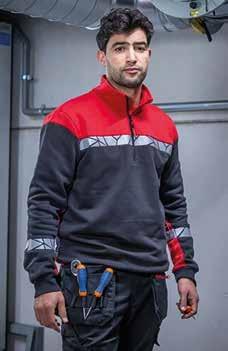
visibility for wearers in medium-risk situations, providing an added layer of safety in demanding work environments.
Catering to a diverse workforce, the PROGRESSION collection offers an impressive 37 distinct styles. This extensive range includes 14 specifically designed for women, ensuring a comfortable and tailored fit for all professionals. The workwear is also available in five versatile colour combinations, allowing for both practicality and a degree of personal preference.
ProJob Workwear products, including the new PROGRESSION collection, are supplied throughout Ireland via a network of distributors. Professionals seeking more information or wishing to place enquiries are encouraged to contact Kildare-based Paul Coughlan at paul.coughlan@united-brands. co.uk or visit the ProJob website at www. projob.se/en
With the launch of the PROGRESSION collection, ProJob Workwear not only delivers high-quality and functional workwear but also underscores its dedication to a more sustainable future for the industry. This innovative collection is poised to resonate with environmentally conscious businesses and individuals across Ireland.
Fit-out and construction specialist Dalmoy has announced the launch of Dalmoy Green, a dedicated subdivision focused on sustainable building solutions. This strategic expansion underscores Dalmoy’s commitment to advancing energy-efficient, environmentally responsible construction practices in residential and commercial sectors.
Dalmoy Green will provide homeowners and businesses with expert guidance and cutting-edge sustainable solutions, including advanced insulation, high-efficiency heating systems, smart energy management, and renewable energy integration.
Stephen Daly, Managing Director, Dalmoy, commented, “Paddy (Moyles) and I have been fortunate to build Dalmoy into a thriving company, but our vision goes beyond performance. We want to make a lasting impact on the industry.
“Dalmoy Green is the next step in that journey, driving sustainability in construction and fit-out across Ireland. We aim to reshape industry thinking, prioritising energy efficiency and environmental responsibility while helping clients reduce their carbon footprint.”
To spearhead this initiative, Dalmoy has appointed Noel Donnelly as Head of Operations for Dalmoy Green. He has extensive experience in sustainable
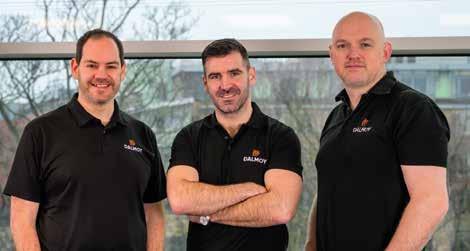
construction, managing large-scale projects for global companies with market-leading sustainability targets. His expertise spans A1-rated buildings, BREEAM and LEEDcertified developments, and integrating renewable energy solutions into modern construction.
Speaking about his appointment, Noel Donnelly said, “I’m thrilled to join Dalmoy at this pivotal moment. Dalmoy Green is set to transform how we approach energy efficiency in construction. We aim to make sustainability practical, accessible, and cost-effective, ensuring our clients achieve long-term savings while reducing their environmental impact.”
Paddy Moyles, Construction Director, Dalmoy, added: “With Noel leading the charge alongside our energy partners, we are excited to champion sustainable solutions and grant-funded initiatives that make greener buildings more accessible. This is the beginning of a more sustainable future with Dalmoy Green.”
Dalmoy Green and its sustainability partners will focus on expanding its sustainable construction portfolio, securing key residential and commercial projects, and collaborating with government sustainability programs to maximise energy efficiency grants and incentives for clients.
















Delivering life-changing healthcare facilities across Ireland and the UK
Please visit our website www.sisk.com